2019 Online Gallery
Click on the numbers to see each entry’s caption.
Click on the numbers to see each entry’s caption.
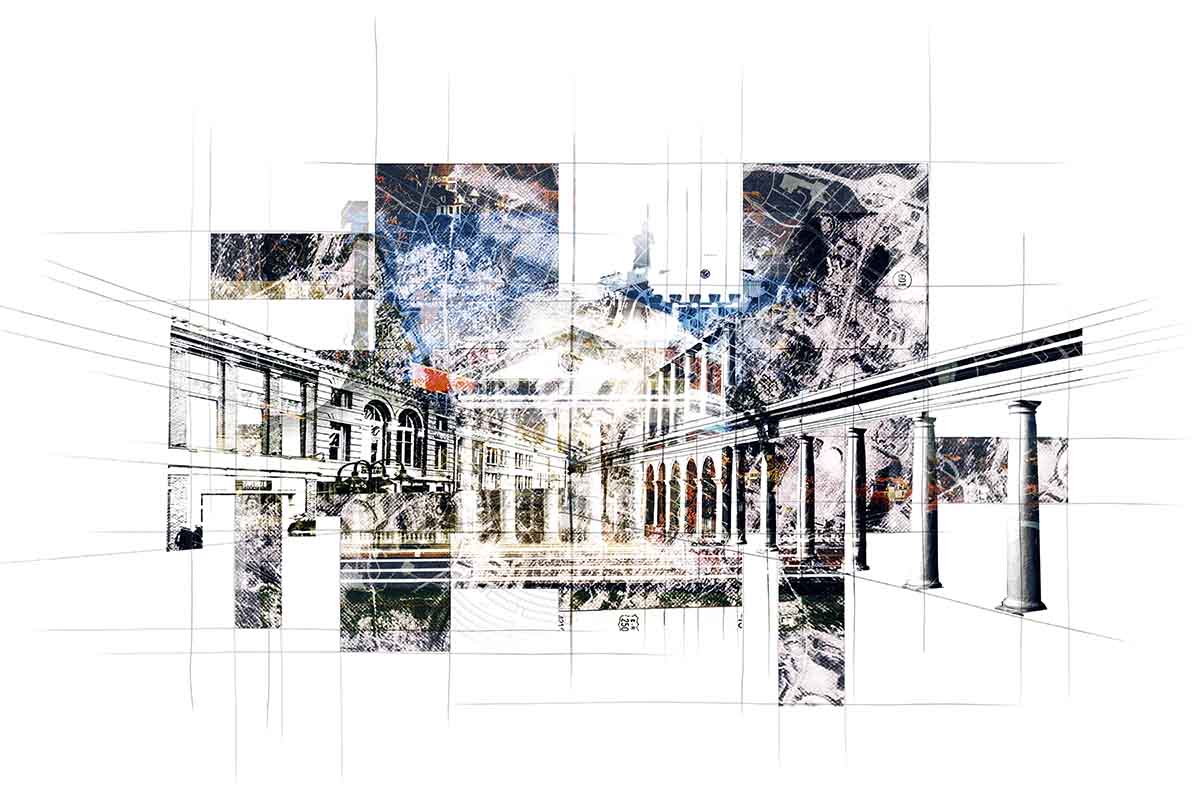
A town nestled in between sweeping mountains and endless fields. It is divided from the rest, like a blue dot on a blank piece of paper. The visitor travels for hours to reach this isolated city, rich in history and culture. The town is a visual collage through the centuries of development. The visitor, walks the brick streets, sees no familiar faces – except those in the books. Unlike the rest, smiling and waving at other locals across the streets. This is a who you know town, but also a get to know you town. This is C-ville. A town with two types of people: the welcoming and the repelling; a town with a clear division, co-existing in the past and the present. C-ville struggles with the desire to remain a small town, but also flirts with the idea of growth and expansion. It boasts the best of both worlds by providing all the amenities of a city but is enclosed by the countryside and vineyards. It has been named one of the happiest places to live but is home to sickening violence.

“This town is the size of a dinner plate” – Dawes
Charlottesville is full of life and death, beauty and tragedy, and love and loss.
We’re small, there’s a lot going on, we’re a little messy, but it’s a meal and it fills you up.
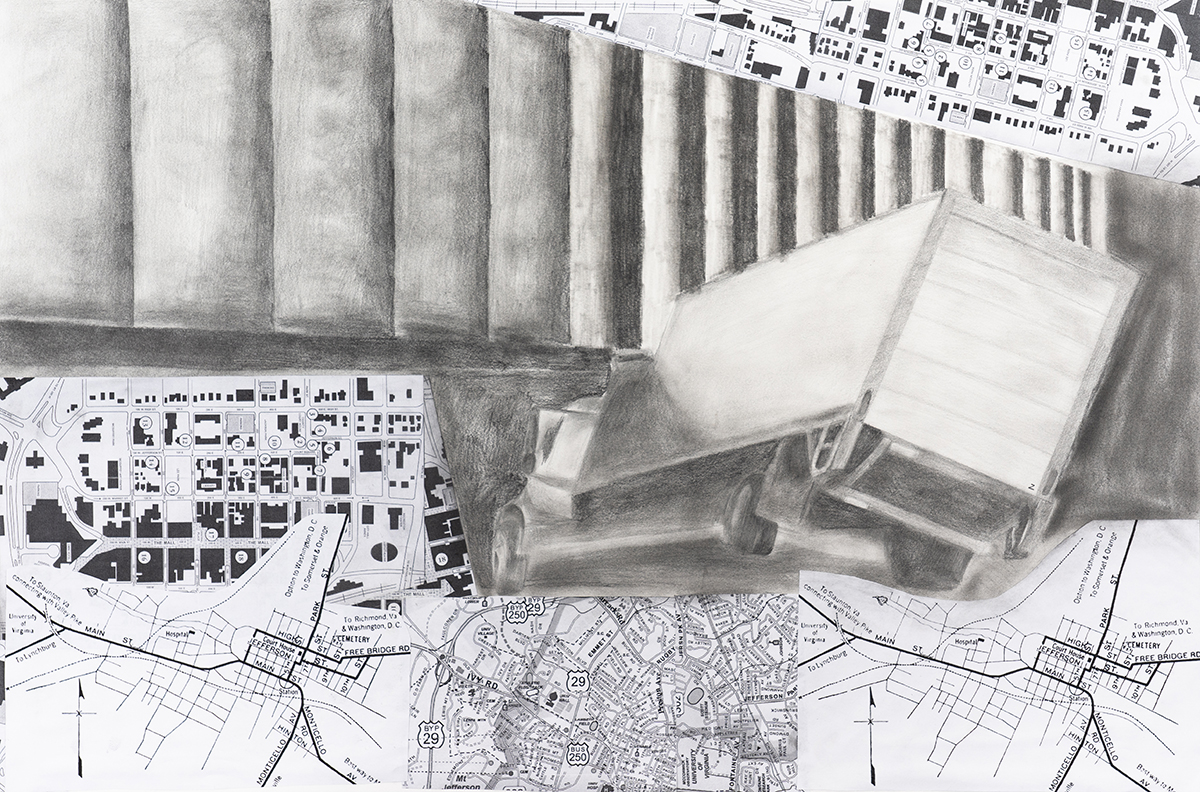
Our drawing depicts a box truck stuck under the 14th Street bridge on the UVA Corner. This is a common sight for individuals on the Corner, with a long-time business owner being quoted as saying, “After a few years of being up there you could just tell that a truck was going to hit…you got to know whether a truck was going to make it or not.” We ran with this idea because although it is an occurrence that locals know all too well, people outside of the city probably wouldn’t recognize the bridge as an immediate threat. This idea of local happenings that don’t make it outside of the city’s reach is the subject that we most wanted to address in regard to an “Invisible City.” A city can have the most vibrant traditions and rich history, but if this knowledge doesn’t make it outside of the city, then it is invisible to everyone else.
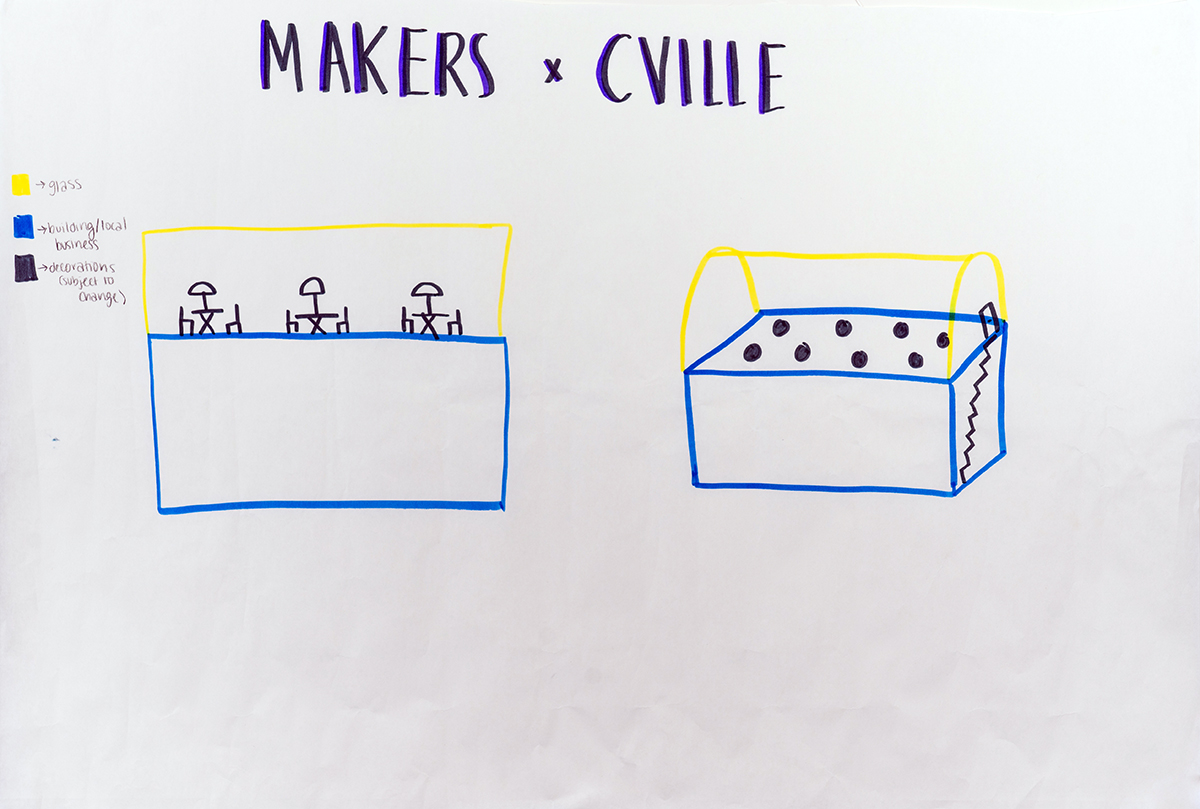
Charlottesville is a city of learners. It is a city filled with people who want to discover things about the world, whether it be artistically or academically. To live in a community of people who are impassioned to explore is a rarity, and it needs to be cultivated and encouraged. In a place as beautiful as Charlottesville, it is a waste that there is no free, public work space that allows its beauty and uniqueness to be used as inspiration, which is why I propose a series of rooftop work spaces, open to the public, placed on top of local businesses that are central to our community. The project would be called Makers X Cville and it would be a community based program with the goal of providing all of the creative thinkers of Charlottesville with a space that is easily accessible to all and will allow them to share ideas with people they might not meet otherwise. A resource like this offers inspiration, collaboration, and an opportunity to learn from each other in an inviting space.
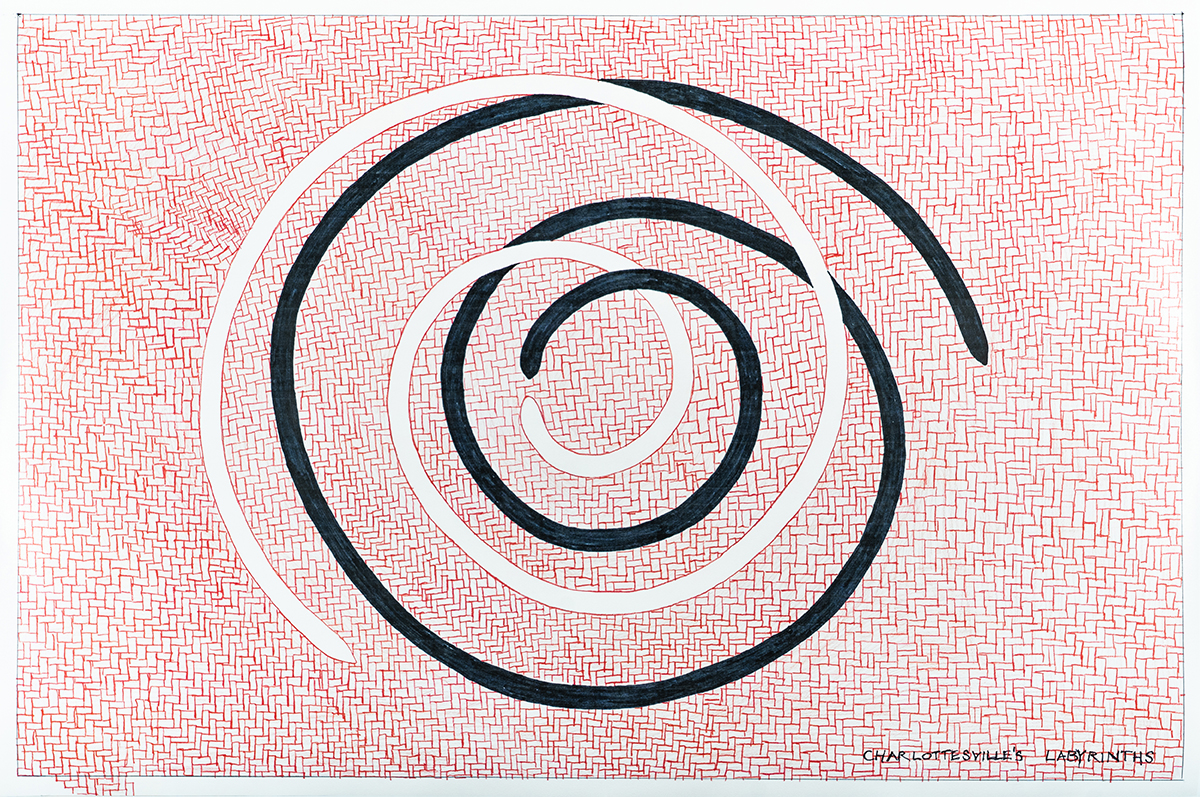
The unassuming traveler wanders into Charlottesville and finds a happy and diverse college town with blacks and whites living in their tidy neighborhoods employed in their various pursuits. But under closer examination, they notice two tangled yet distinctly separate winding paths superimposed on the street. Blacks walk one path and whites the other. These paths sometimes overlap, but they never connect. Both groups move slowly along, living their lives, paying little attention to each other.
Despite the enormous improvements in attitude and behavior between the races over the last hundred years, there still remains a deep unconscious divide that will take many more generations to overcome.
Charlottesville's labyrinths begin far away from each other, and although the black's path looks to be a bit longer and seems to have more curves, both optimistically spiral closer and closer until, in the end, they meet.
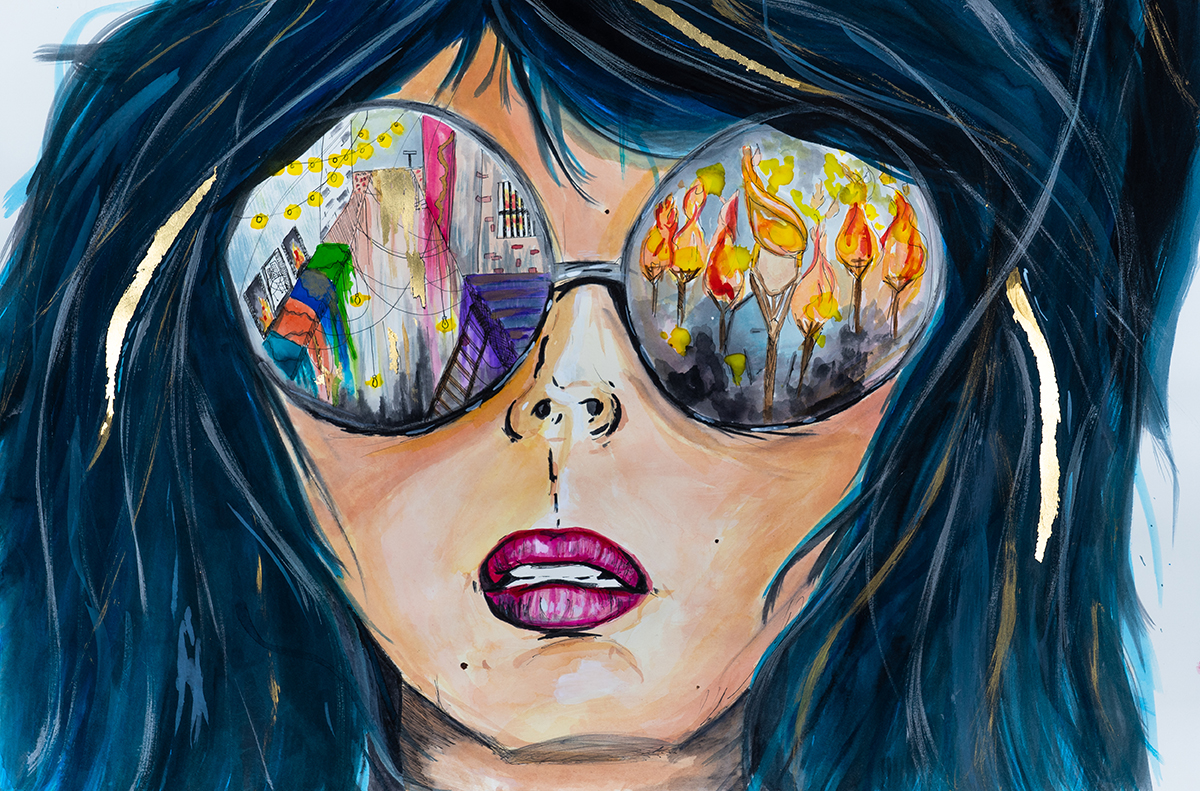
“The inferno of the living is not something that will be; if there is one, it is what is already here, the inferno where we live every day, that we form by being together. There are two ways to escape suffering it. The first is easy for many: accept the inferno and become such a part of it that you can no longer see it. The second is risky and demands constant vigilance and apprehension: seek and learn to recognize who and what, in the midst of inferno, are not inferno, then make them endure, give them space.” – Italo Calvino, Invisible Cities
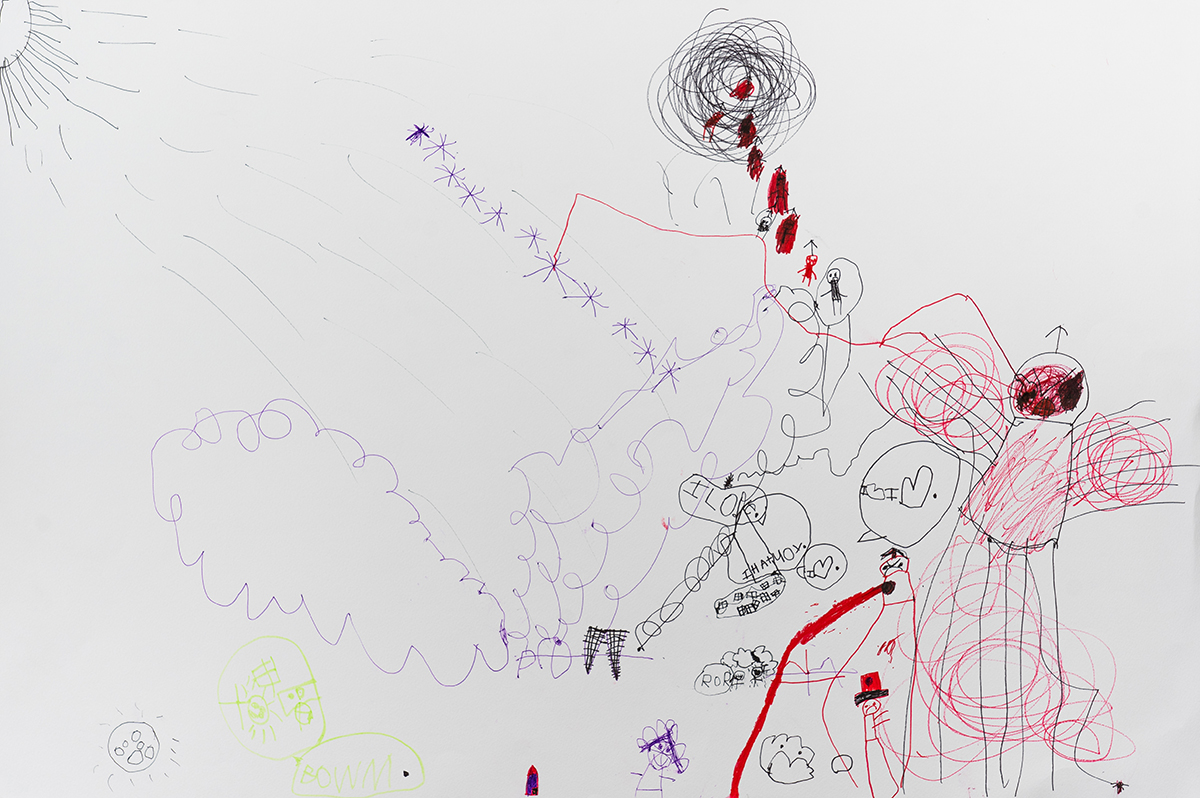
When I discussed the theme of the competition with my son, 6 years old, he said:
“I’m not somebody that knows a lot about what people don’t know about our city.”
I read the brief to him and explained the section that mentions an ‘experience or story that characterizes Charlottesville.’
So he drew a story.
It is complicated, as such things can be, it involves an alien invasion by a squid monster and people getting sucked into a black hole. You can see bits of the city in houses and buildings, the sun and the rising moon. What it boils down to is a story of two unlikely friends, a witch and a man, who work together to save the people of the community. Learning to love people that are different than you and helping where you can.
That seems right.
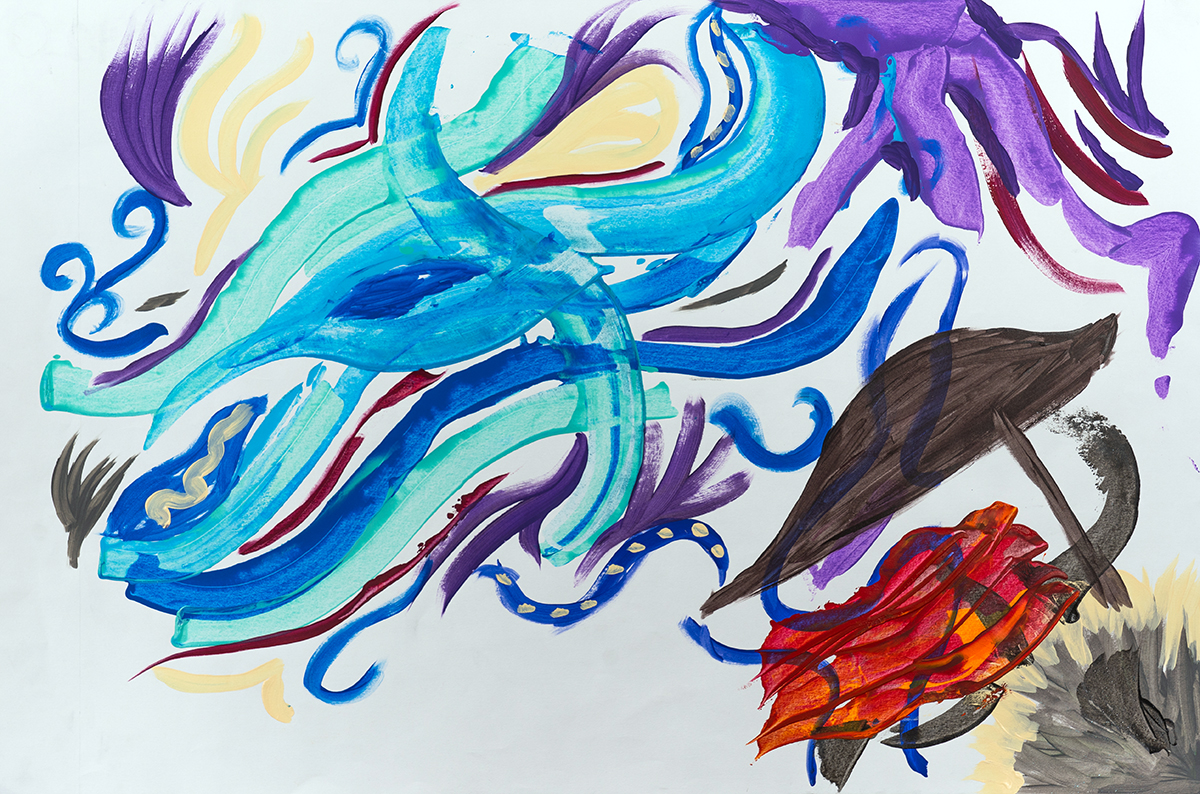
Now. Now is the most tempestuous, turmoil filled, hectic time in my life, and yet others expect me to be happy. Others expect me to have solutions to all their problems and answers to their incessant sea of questions, but it is all I can do to stay afloat. At times it feels as if even the planks on which I stand to brave out this storm I have raging inside of me have caught on fire. At times it feels as if a kraken itself has risen from the depths of the ocean and is coming to drag me back into its watery tomb. The very sun itself is turning black and threatening to swallow me from above, and all the birds have stopped singing. It is from this place of alienation that I brought forth this piece representing this time of great transition in my life. The emotional upheaval I feel as I move on in my life, as I figure out how to be my own man, as I figure out what it means to be a man, has produced this physical manifestation of my innermost (Write it!) feelings.
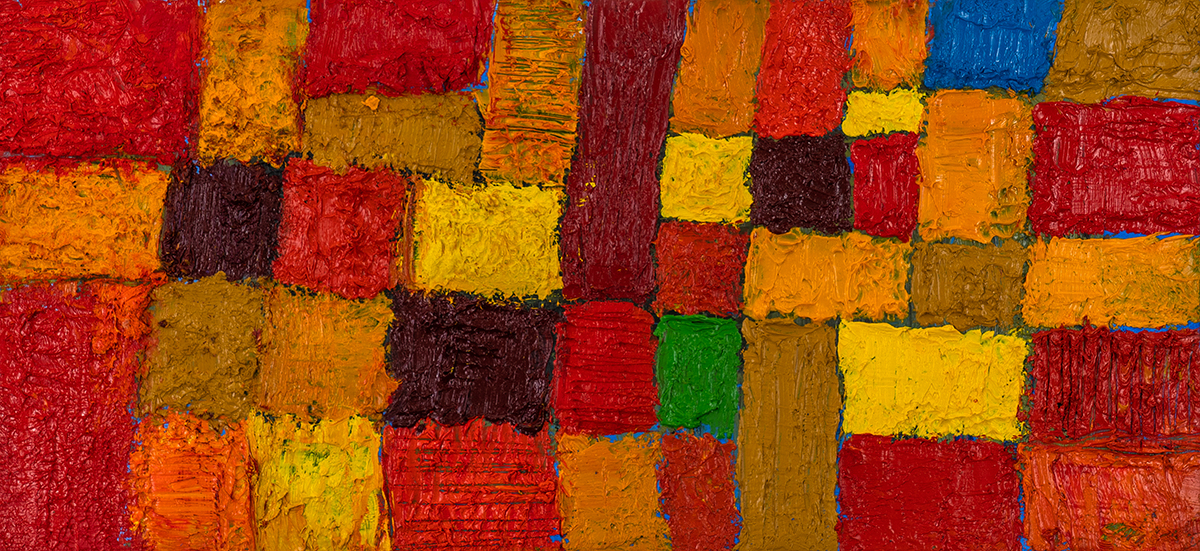
“Ever Since (Cumulative)”
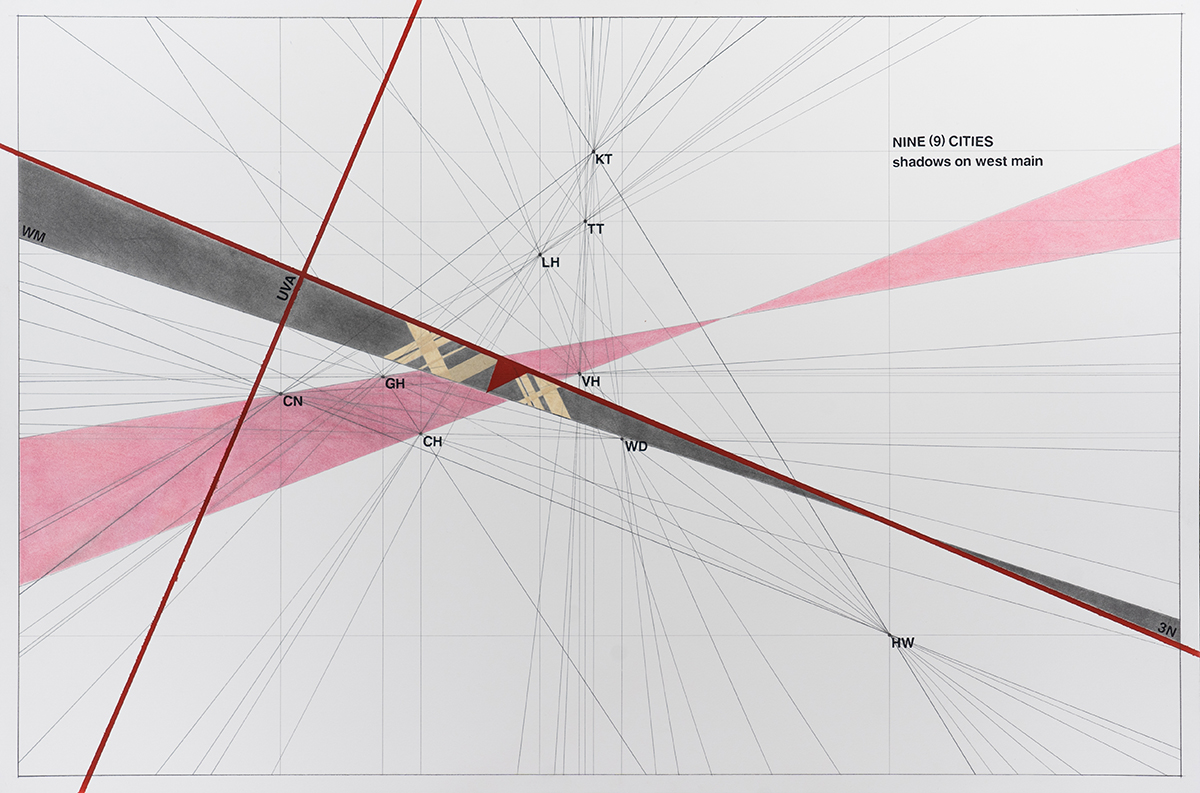
NINE (9) CITIES
This is a critique on those Invisible Cities that have been lost in the development of the City of Charlottesville.
Italo Calvino’s Invisible Cities is organized upon nine (9) chapters that provide a structure to illuminate eleven (11) internal themes. This forensic mapping investigation follows similar guidelines to uncover the spatial relationship among nine (9) Charlottesville neighborhoods that have fallen victim to development throughout history.
shadows on west main
The array of intersecting lines reveals the invisible city center along West Main Street. The shaded representation of West Main is a critique of the towering shadows of development that threaten the progressive streetscape design and the preservation of the area’s history and identity.
This analysis posits the potential cost of continued development and urges that each step forward reflect upon the past.
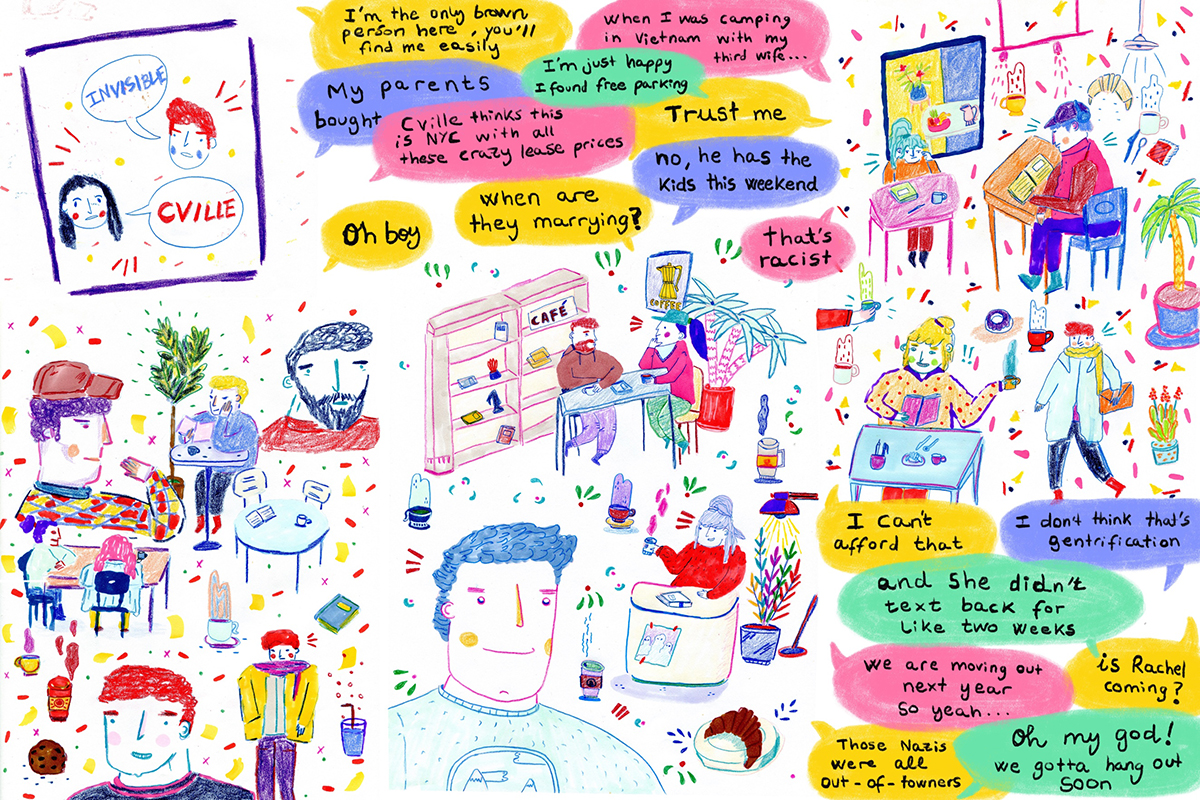
“Overheard at a Café” offers a kaleidoscopic view into real conversations happening across Charlottesville’s coffee shops. What is invisible to us is perfectly identifiable in this heteroglossic piece. Listening carefully to these fragments one can see more than meets the eye. How do “true” and “real” equate in these bits of conversation? This work actively poses the question of whether these voices merely coexist or if they build off each other like collage cutouts. It purposely mirrors viewers’ reflections to make them reflect on the untold and unresolved stories of Charlottesville’s daily life. I ask you: where does your voice stand in our community?
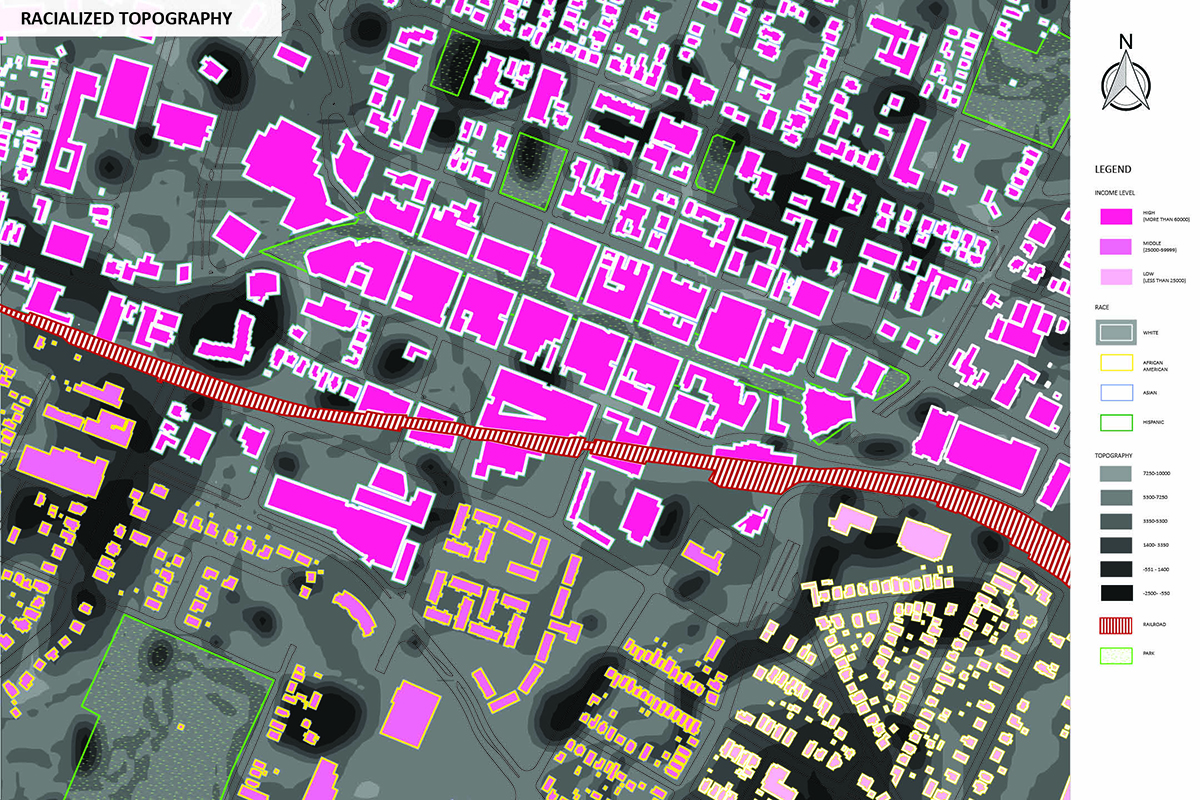
Charlottesville’s urban form can be read as a racialized topography. Building environment which represents topographical qualities, is an active agent in the formation of race, identity, belonging and exclusion.
With a severe racism issue, an eruption of racist violence was triggered in 2017. Charlottesville became a symbol of political turbulence nationwide. Racism today, is embedded in the daily life of Charlottesville: healthcare, education, income, the judicial systems and government itself.
The map of Racialized Topography reveals the invisible relationship between races and elevation in downtown area. The railroad, segregating different urban room, isolates different racial groups physically and mentally. North Downtown is occupied by white and high-income group. South Downtown, which is lower than north area topographically, is occupied by African Americans. Figuring out invisible racialized spaces is necessary for us to energize the development of Charlottesville.
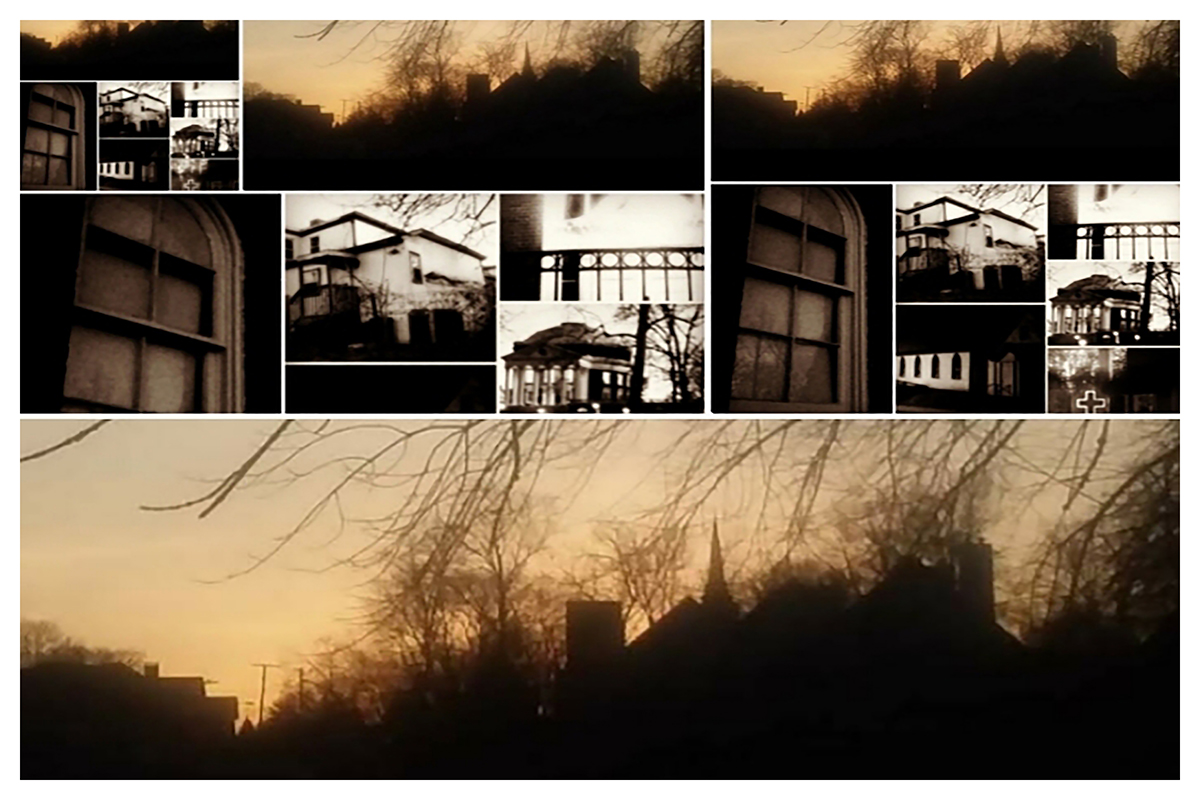
we are all children with sin
living in glass houses
invisible at dawn
cutting the fabric thin
divided deep in the soil
unraveled by loose cannons
beneath mounted Olympus
where we all call home
we are all angels without erasers
crying with lanterns
standing upon the bow
in the dark of despair
with the masses leaning forward
anxious to falling knees
at the hem of blind liberty
on tip toes in the river jealous
painted by bastards ulterior motives
behind the backs of Sunday choirs
we are all prisoners with wings
holding keys for our classmates
monitors with megaphones
standing on parasites
biting in our dreams
holding the tip of our tongue
while wiping tears from holy patrons
paying for solitude with blood in a jar
we are all tiny soldiers
handing out bandaids
whispering for hope
tying limbs taught
in the hard rain
with life preservers for all
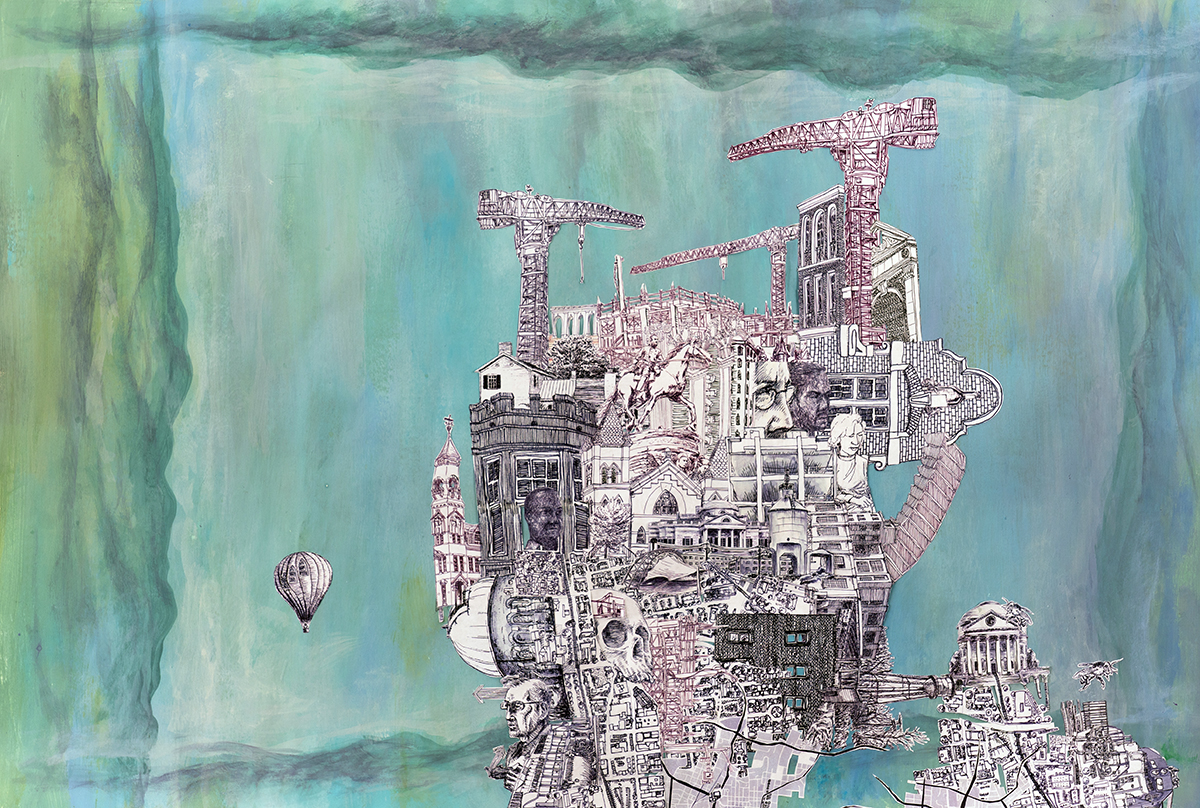
Charlottesville is many things to many people. In her ongoing history, friends and enemies have swept through her streets. Yes, in her early adolescent years, but in recent years as well. Charlottesville’s idyllic beauty, squared lanes, and stately architecture lays over her flawed foundation. Her storied and contentious history is as complicated and organic as a map. And just as difficult to distill down into a legible document. A map by its nature is a snapshot of a specific moment in time. This moment in time is defined by Charlottesville’s residents and the surrounding swirl of history, both cultural and political. A notch’d path. A rich soil. A call for freedom. A plea to learn. A raised voice. An erased community. A hopeful song. A continuous evolution.
I enjoy wondering the streets and parks and soaking up the atmosphere of my adopted home. The historical patina, cracked order and varying seasons fit me better than where I originally come from. I draw the city one element at a time.
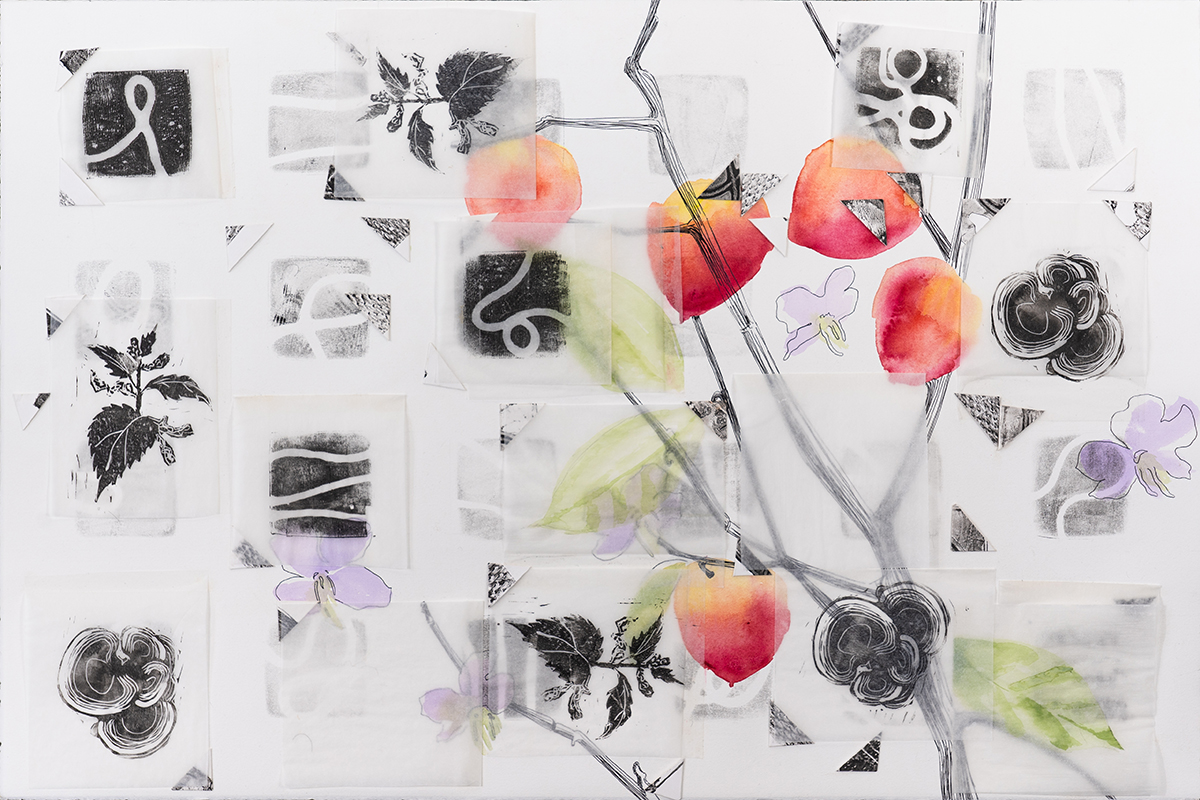
Instructions for viewing: Please extend your hand, please touch this work. The papers are many different textures, and the art is in your movements, your exploration. The opaque pages move, and can be held in new places by sliding their corners into triangle pockets. Sometimes the fit is snug and what is underneath is visible. Sometimes it isn’t.
In seeking to uncover the hidden, invariably the whole picture changes. Investigate one detail and others become more opaque. Erect walls and houses to map the grid, to hide our paths and habits. Move about your space so that your footsteps are ghosts, worn floorboards, chipped paint. Try to know a piece of art like a city – without being able to see it all once. The detritus of edible flora, strewn in the yard.

Imagine you are sluicing for gold, shaking a pan beneath the water until the earth and pebbles are washed away, leaving only the gold itself.
When we walk through a familiar urban landscape, we toggle between a wide relaxed gaze and a narrow focus. When the eye relaxes it sees the broad character of place, an aggregate of parts. Then something stirs: a dozen starlings light upon a wire and this reminds us that our eyes can hunt.
If we target our surroundings using just our eyes, we might notice the line down the middle of a street joining up in the distance with the overhead wires in the sky, or a particular rhythm of windows and its relationship to a strong diagonal.
Two of us wandered our city and captured broad photo images and two of us used those photos to extract a hidden design, teasing out shapes and patterns hiding in plain sight.
We invite you to try it. Walk the city and illuminate the invisible. Shake the pan for gold.
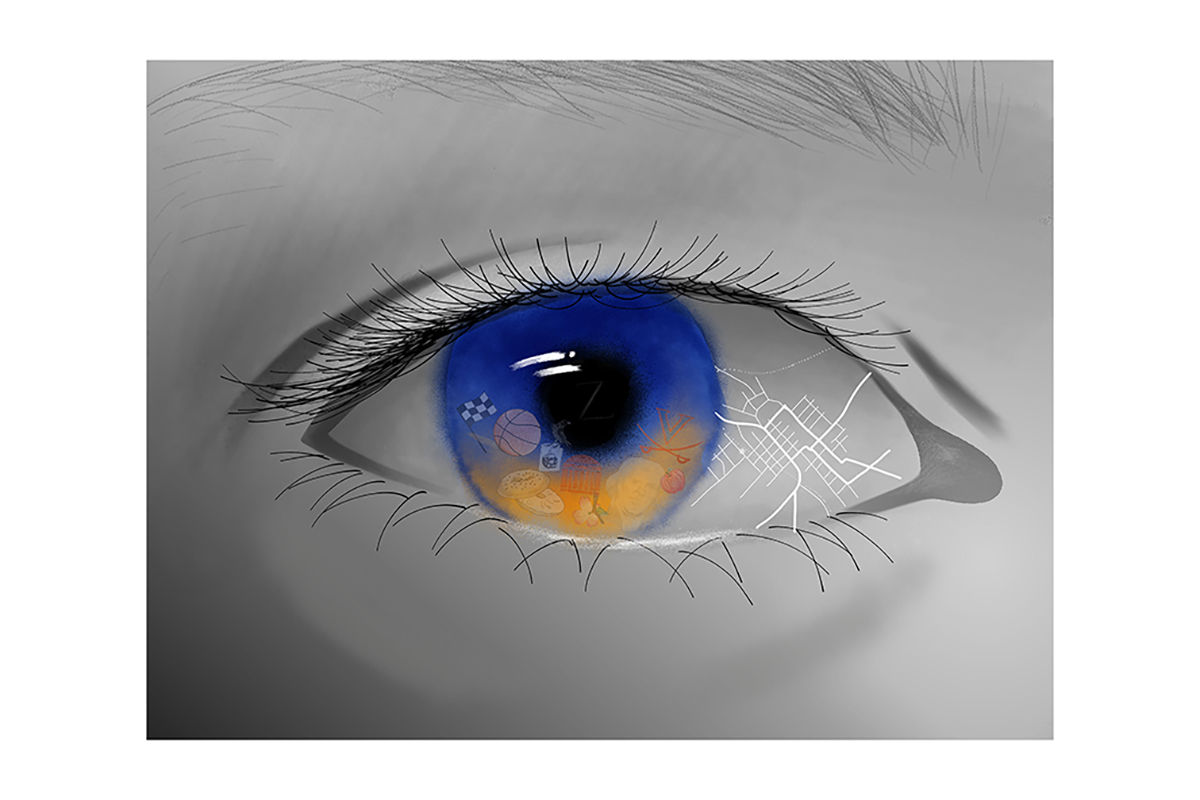
Some say that human eyes are windows to the soul. This eye represents what people envision when they think of Charlottesville. The iris is blue and orange because University of Virginia is the main focal point of the city and these are their school colors. The white area of the eye is made of lines that represent the city map. The images placed in the bottom half of the eye are important features that encompass Charlottesville as a whole. The images are faded to represent the transparency concept suggested by “Invisible C’Ville”, with the theme inspired by Italo Calvino’s Invisible Cities. The book connects to our idea of Charlottesville since it states, “Cities, like dreams, are desires and fears, even if the thread of their discourses is secret, their rules absurd, their perspectives deceitful, and everything conceals something else” (Calvino). We wanted to represent Charlotteville as the beautiful, historical city that it is, and it should always be remembered as such.
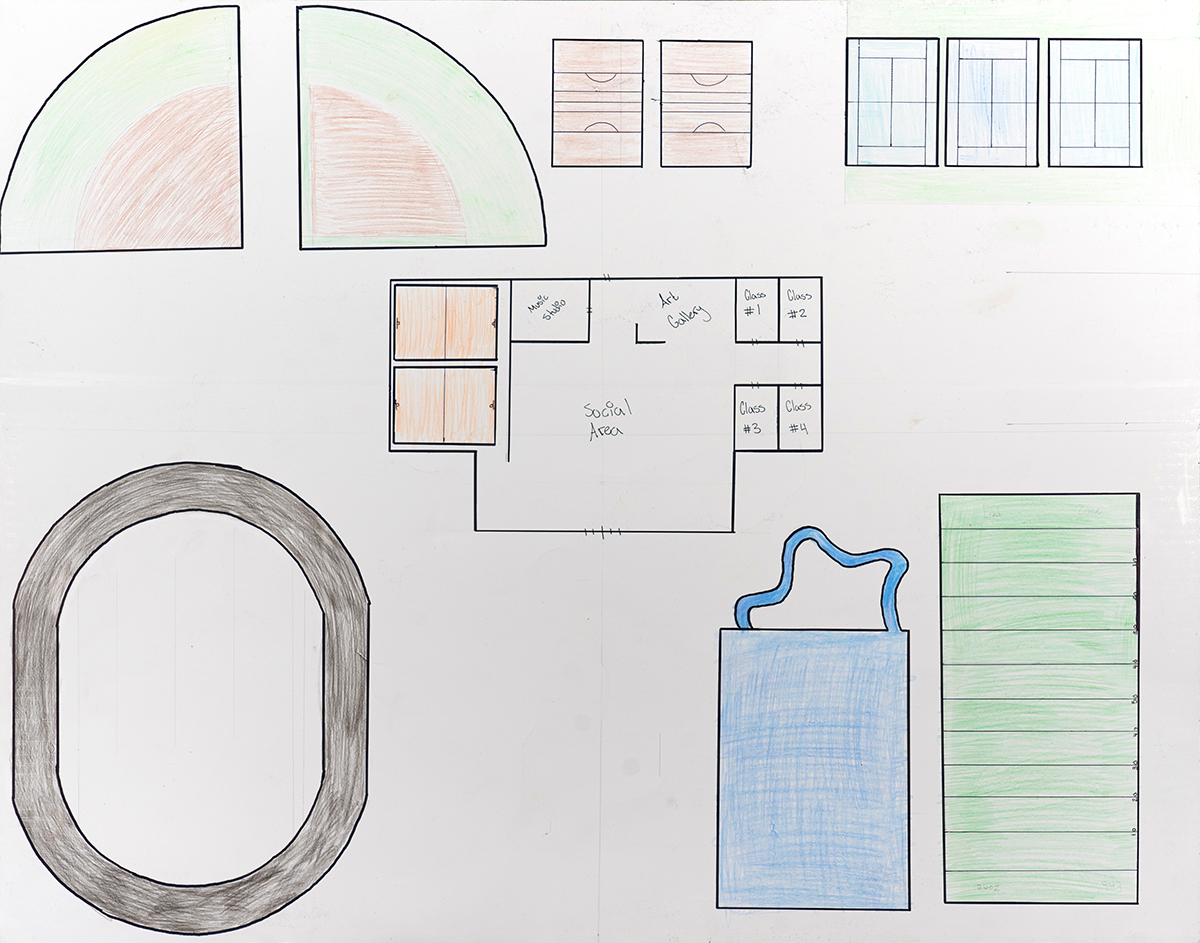
Growing up, I played a variety of organized sports to become a diverse athlete. From one sport to the next the one that I really stuck to Football. This was the sport that made me happy, and made me feel like I was living my best life. Unfortunately, I had nothing to do outside of football season. I always wanted to go out and play sports with my friends. Sadly, I wasn’t able to go out as much because my family didn’t have the money. Many things for people to do in this community aren’t affordable for everyone. Included in my vision are rooms in which classes can be held for students who want their life to correspond with sports. Not only for student purposes, this project can be open to the public when classes aren’t in session. In order to remain established, of course there will need to be a source of income. I believe that if you buy a membership here the price should be based on income. This center will be great for everyone. This is my hidden Charlottesville.
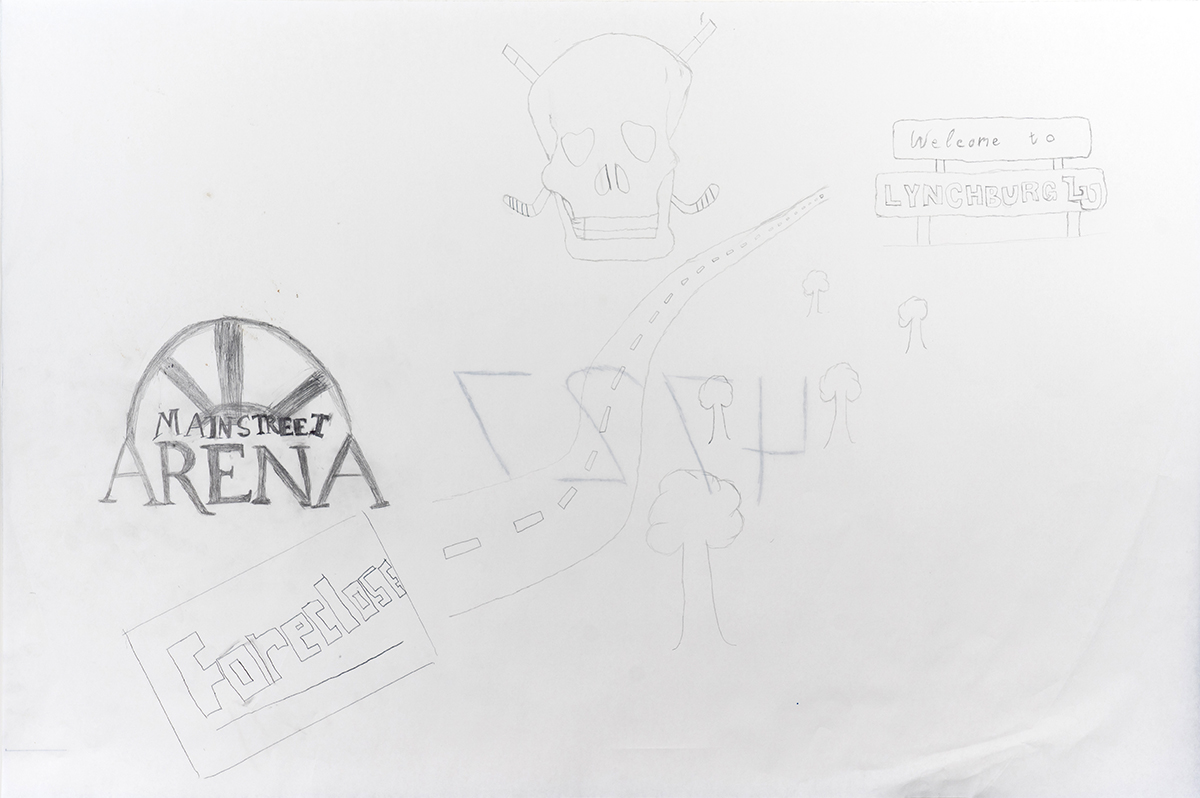
Hockey in Charlottesville never attracted the masses. To those it did affect, though, it was, and still is, cult-like. I’ve been playing hockey since I was six, skating since I was four and anybody who knows me can confirm that I spent at least two hours everyday at Main Street Arena, formerly the Charlottesville Ice Park. I am not unique; I have gone through ten years of youth hockey with largely the same fifteen kids every step of the way. Now, my team and I have to travel to Lynchburg every Sunday for practice. But I have no doubt in my mind that three hours round trip is worth an hour and half with my skates on.
I barely ever go Downtown now. I don’t really want to. I went to a movie about a month ago and forced myself to go look inside one of the rink’s windows. What I saw broke me, a shell of my home away from home. It was gutted. Something so integral to my childhood began its demolition unceremoniously ten days ago but I’ll still go Lynchburg and put my skates on this Sunday.
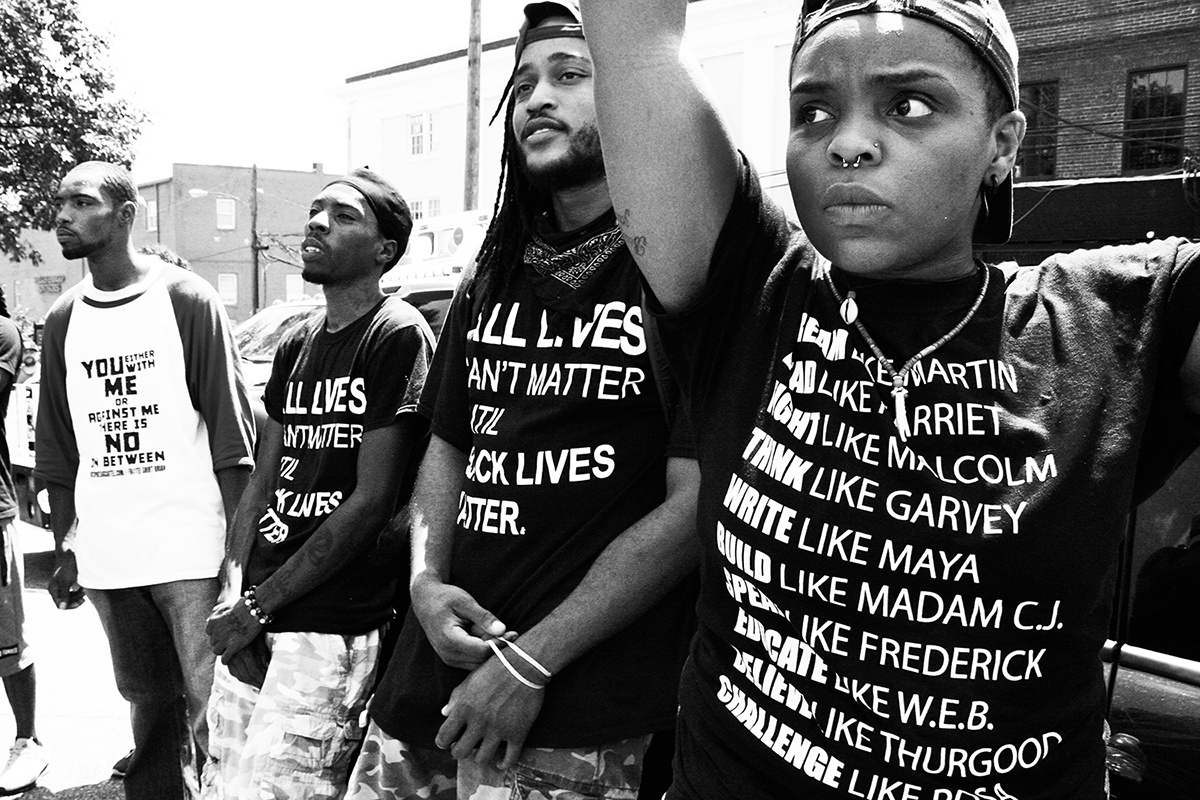
Dream like Martin. Lead like Harriet. Fight like Malcolm. Think like Garvey. Write like Maya. Build like Madam C.J. Speak like Frederick. Educate like W.E.B. Believe like Thurgood. Challenge like Rosa.
Challenge like Rosa.
Resolute young protesters on August 12, 2017 do the hard work of challenging racist ideology on the streets of Charlottesville, Virginia. We have a long way to go but we take courage in the strength and righteousness of our next generation.
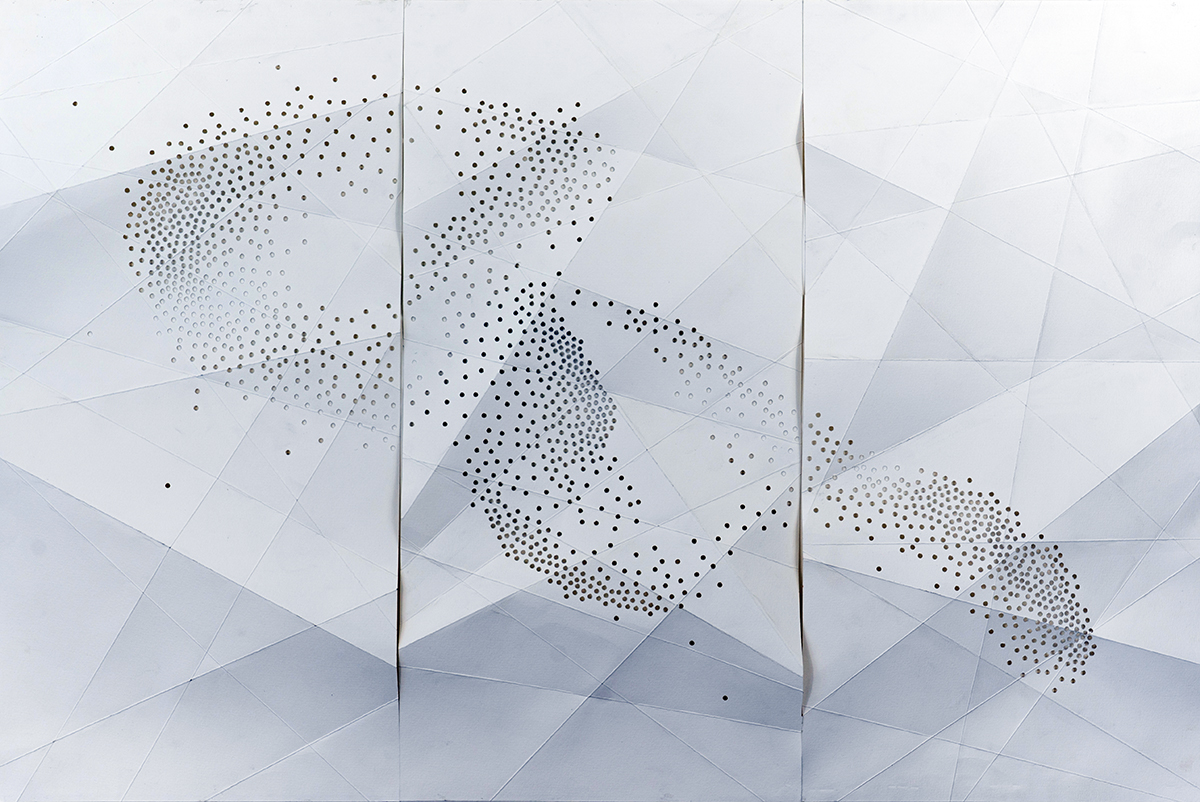
“Something runs among them, an exchange of glances like lines that connect one figure with another and draw arrows, stars, triangles, until all combinations are used up in a moment…” – Italo Calvino
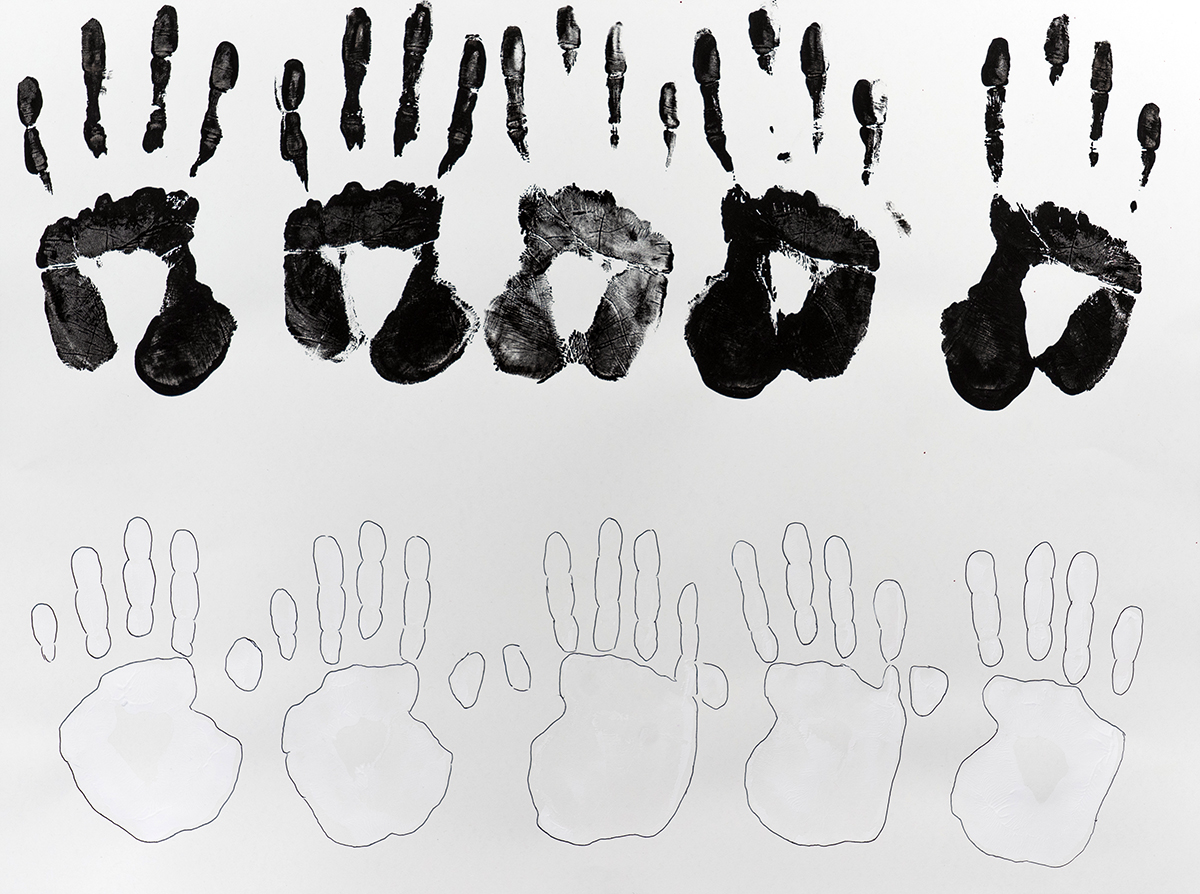
A Collection of Color
Black Hands, Black Hands
You’ve structured our home
White Hands, White Hands
You’re imprints graved in stone
Black Hands, Black Hands
You bleed History’s pain
White Hands, White Hands
You are History’s gain
Black Hands Black Hands
You have all the power you need
White Hands, White Hands
You just need to let go of that greed
Lit cigarettes flicked
At innocent kids, they
Cry out in pain as flame meets skin
“That would never happen here,”
Why do we deny wrongdoings?
Why doesn’t the University acknowledge
This history, it can’t be ignored.
“That would never happen here,”
When it’s happened over and
Over again.
We can’t be united when we’re on different sides.
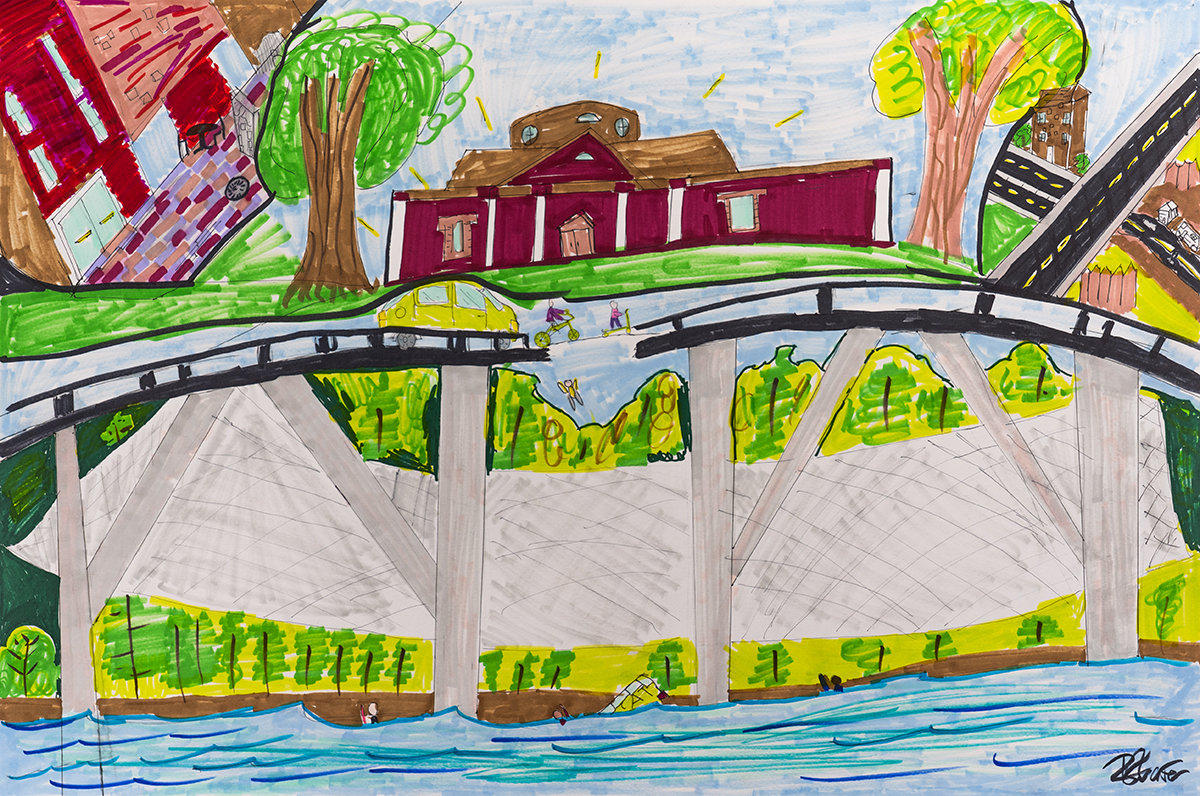
This is a mixed media piece exemplifying the hidden aspect of Charlottesville that I feel like people are aware of but tend to gloss over when thinking about our city. I chose the theme of crumbling infrastructure and overt gentrification, so that I can lense how people tend to notice and live with their fellow citizens in poverty yet they forget that there is hope for escape of it, rather than just removing and displacing poor people from their historically owned neighborhoods. I also wanted to exemplify the deep held roots that exist and how they continue to affect our society today.
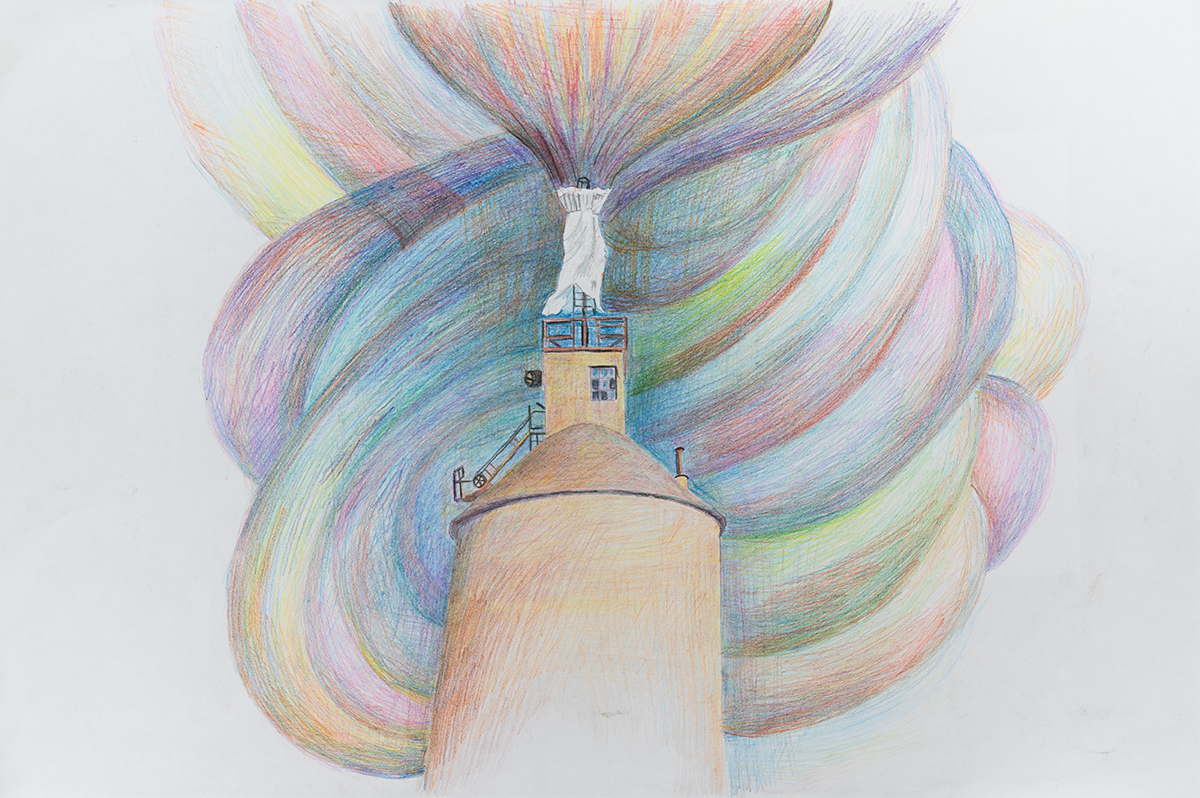
Redress
My entry for Invisible C’ville is to redress the bones of the Monument to Sally Hemings, a sculpture originally of steel and fabric by the artist Todd Murphy which was installed on the Charlottesville coal tower in 2000 as part of the exhibition Hindsight/Foresite. To me, this is a monument to Sally Hemings and to all women: a faceless timeless image in the spirit of the Paleolithic “Venus” figurines.
Her beautiful white dress, blowing in the wind, is a vivid memory from the early 2000’s. She is sited beautifully above the coal tower, above the waters of Water St. When viewed from the Belmont Bridge at sunrise she is a translucent backlit angel. In the evening she says goodnight amidst the rainbow sunset. She is a mythical goddess, Charlottesville’s own lady liberty, perhaps leading us toward a gylanic* future.
I propose re-dressing this monument to make the invisible, a beacon, lighting the way forward.
*Gylany: a social system based on the equality of women and men.
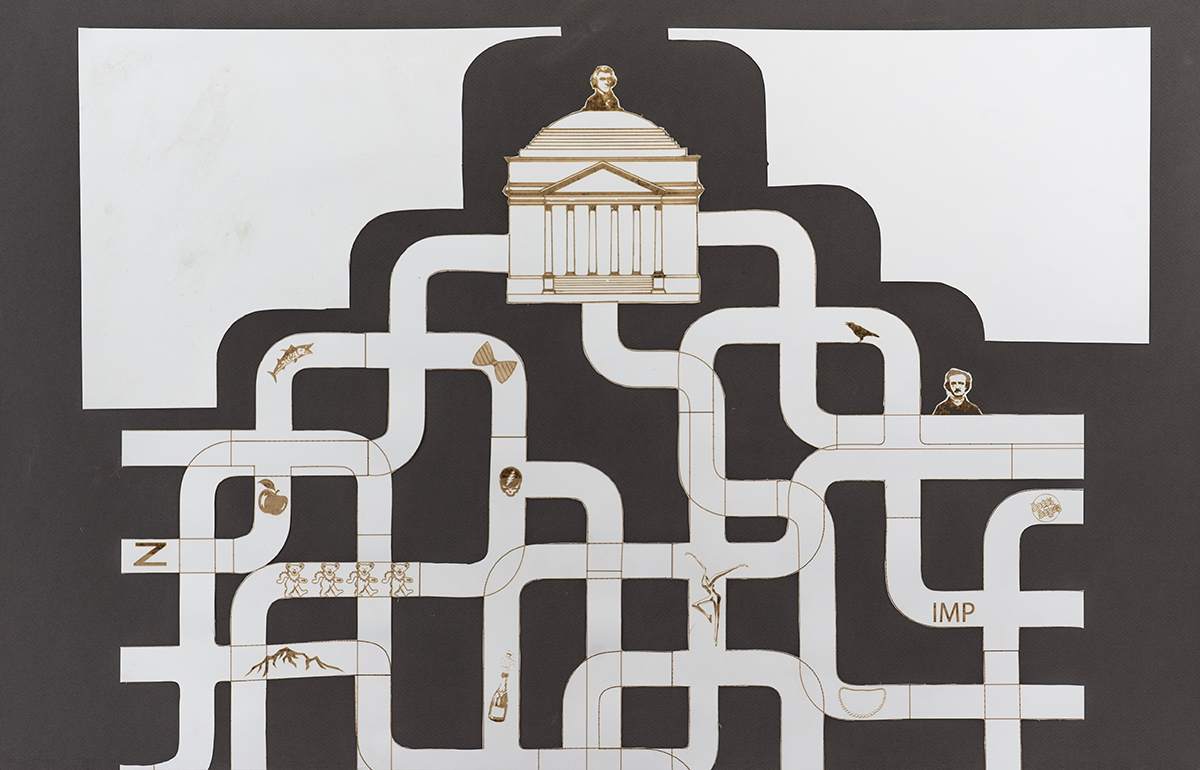
When walking through Charlottesville, it is hard to tell what time period one is in. The history and culture creates a timeless atmosphere that is easy to get consumed by. Within the architecture, especially in the University of VA’s campus, you see Thomas Jefferson’s vision of what he wanted the campus to live up to. He knew what beauty and elegance the people of Virginia have, and he wanted to create a place to represent that. The people are highly educated and have a tight sense of community within the city. The music is vibrant and lively; intertwining with the people. The psychedelic music, which died in other places, is appreciated in Charlottesville. It shows how they appreciate the culture of the past, while also staying up to date with modern society. Charlottesville, VA is a city containing a variety of culture, art, and history that anyone can enjoy. The city combines southern charm with modernization. One should take time to explore the city to unfold its secrets.
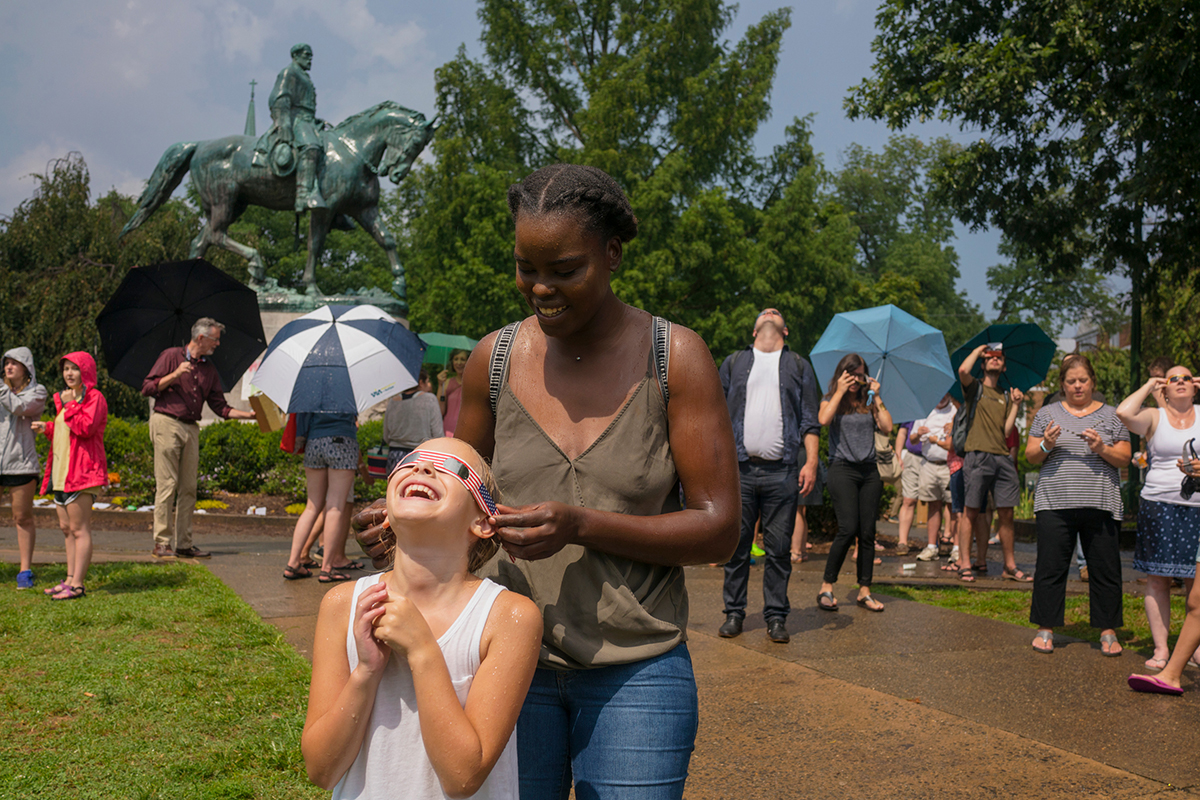
On August 21, 2017, only 9 days after the violent Unite the Right Rally, members of the Charlottesville community gathered in Market Street Park to observe the eclipse. I was still reeling from the violence that I witnessed in my home town while on assignment for The New York Times. I decided to bring my daughters to the park as a chance to find some closure and healing. We stood in pouring rain for over an hour before the eclipse became visible from behind the clouds. My children were soaked, and their eclipse-viewing devices ruined. As we stood in the park watching people watch the eclipse, a young woman emerged from the crowd, approached my daughter, and offered her glasses. My daughter looked skyward, her hands clasped together enraptured, as she saw the eclipse. I made a picture. This gesture of kindness from a stranger was the first step in allowing my broken heart to heal.
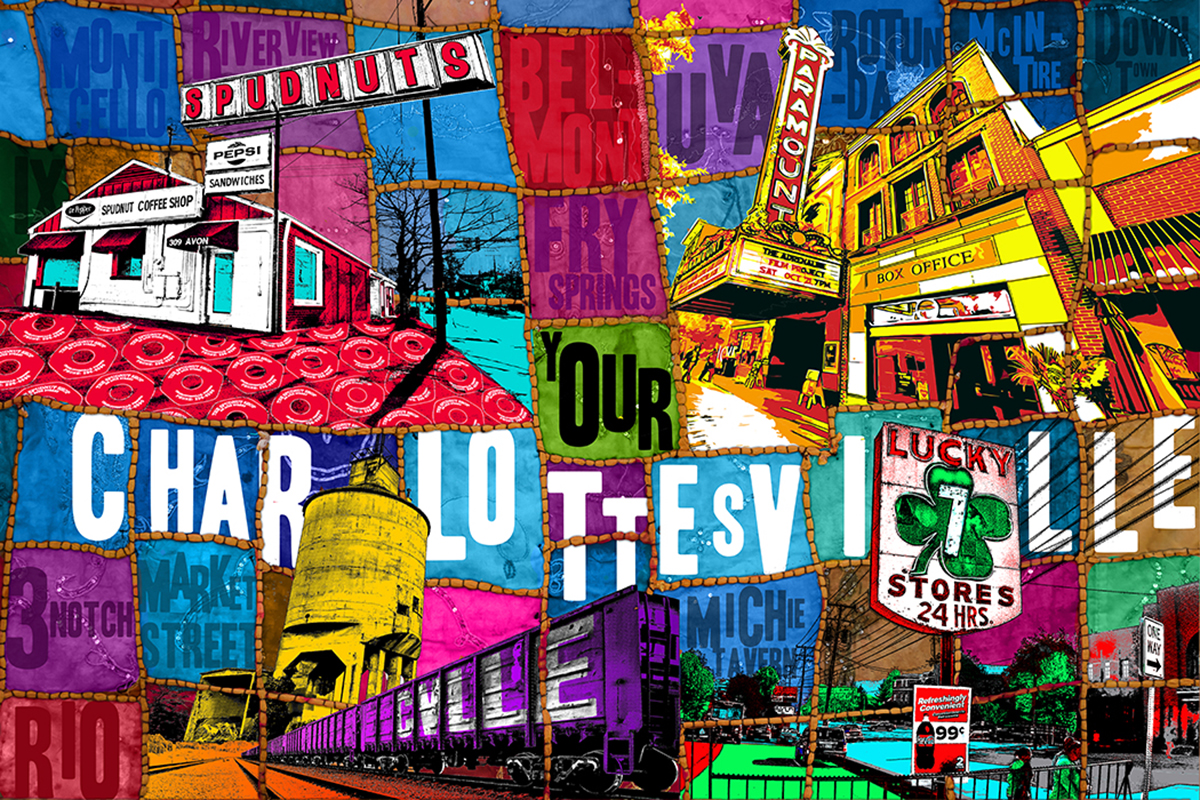
Our town Charlottesville. Visiting downtown Charlottesville on any particular day is a bit of an event. There’s always a chance encounter with an old friend, an interesting performance, a perfect gift to find, and plenty of good food to eat. It’s not just one thing that makes Charlottesville special - all its experiences threaded together makes Charlottesville completely unique.
As with a beautiful homemade quilt made by many hands, Charlottesville’s community is a tapestry of ideas, people, places, and culture. It’s not just one thing but many things interwoven by thousands of people, each giving personality and color. Together, we make the tapestry that is Charlottesville. It is our town.
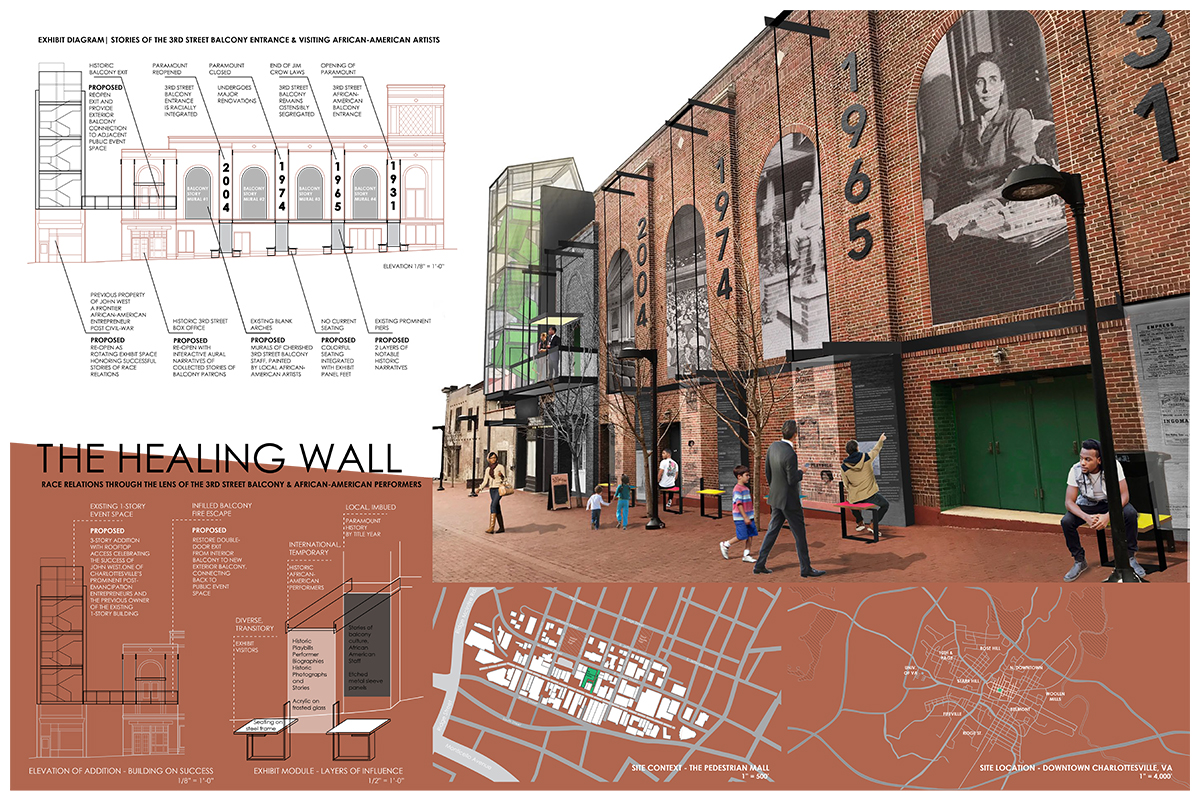
The Healing Wall is a visual, textural, and aural display of the stories of 3rd Street including the Paramount’s segregated entrance. The theater was listed in the Greene Book.
The East Wall of Third Street is re-conceptualized to reveal the stories of individuals who through their courage provided incremental progress in overcoming segregation and separation by race. The vision for The Healing Wall is to claim the landscape of the Paramount’s 3rd Street facade to tell constructive stories of racial integration, those individual encounters and friendships across races, from staff to patron, from performer to audience member.
The design utilizes a layered approach to graphically tell these stories. The outer translucent layer is “conceptual movie posters” that depict performers and shows at the paramount, with lessons of how performers of color courageously overcame barriers to perform their art.
106 3rd St. housed the Barber shop of the Issacs / West family, a multi-racial family that broke through many barriers.
The design attempts to encourage more comfortable conversation about racial struggles, misconceptions, and shared achievements.
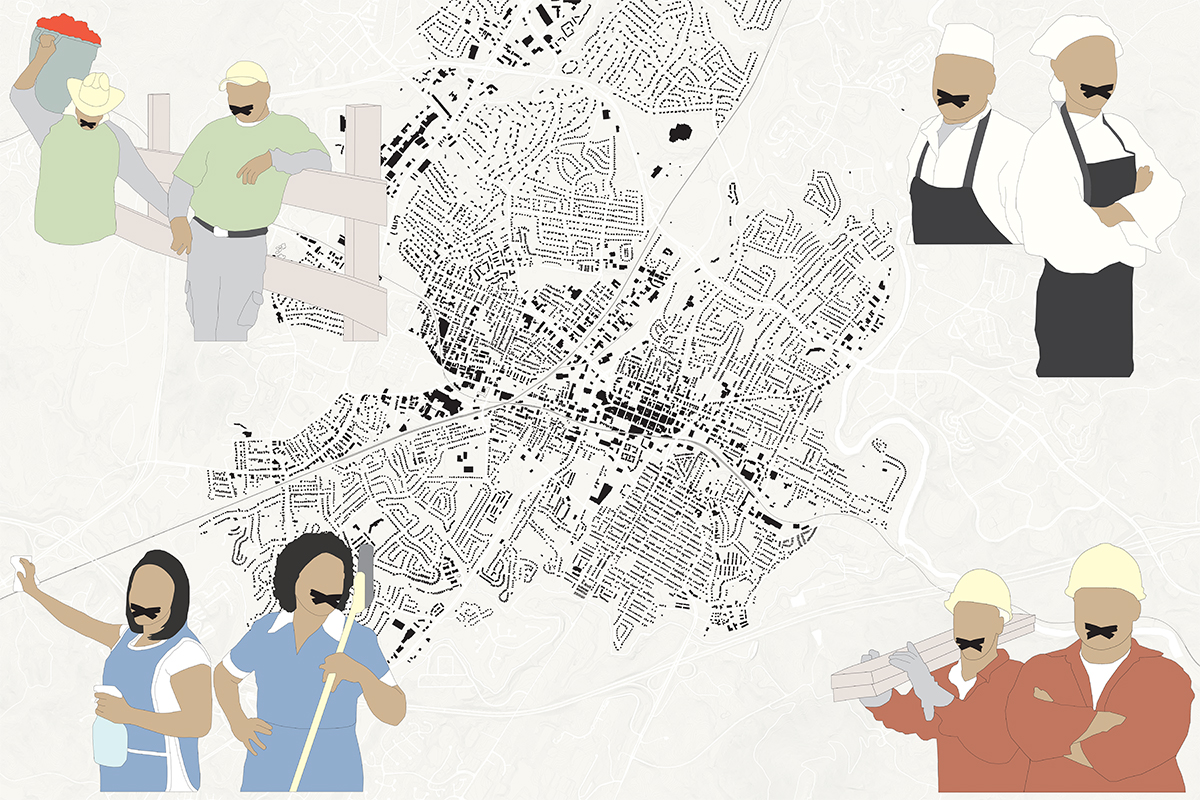
Ya estamos aqui. We are already here. We repair the roads that brought us, and build the structures that shelter us all. We harvest the crops and cook the food, tend the stables and repair the fences. We clean the offices in the dead of night, and work long hours while our children get cared for by their siblings. We came for opportunity. We came to escape violence. We came from villages with no running water, and cities owned by the cartels. We send money home, for our ailing parents and crumbling towns. Here, we are silenced, and we are silent, yet we remain. We work where we cannot be seen, and live in areas that are undesirable. In maintaining this community, we maintain our communities. So, enjoy your roads, and take shelter in your houses. Be nourished by your food and overlook your clean spaces. You can build your walls and send your armies, but we come because we have to, our options are few and our hope is everlasting. Ya estamos aqui. We are already here.
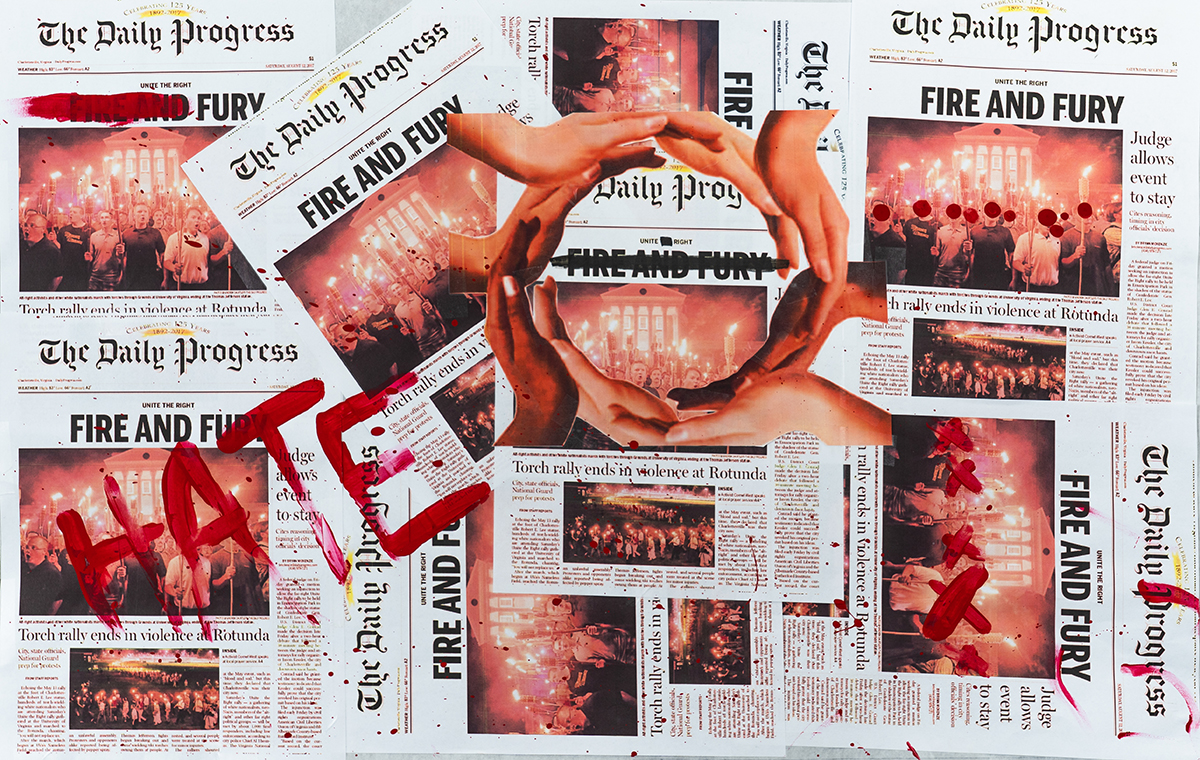
This piece is meant to encapture the chaos that ensued around August 12th and the events that circled around it. I wanted to share a sense of unity within Charlottesville, especially after being divided.
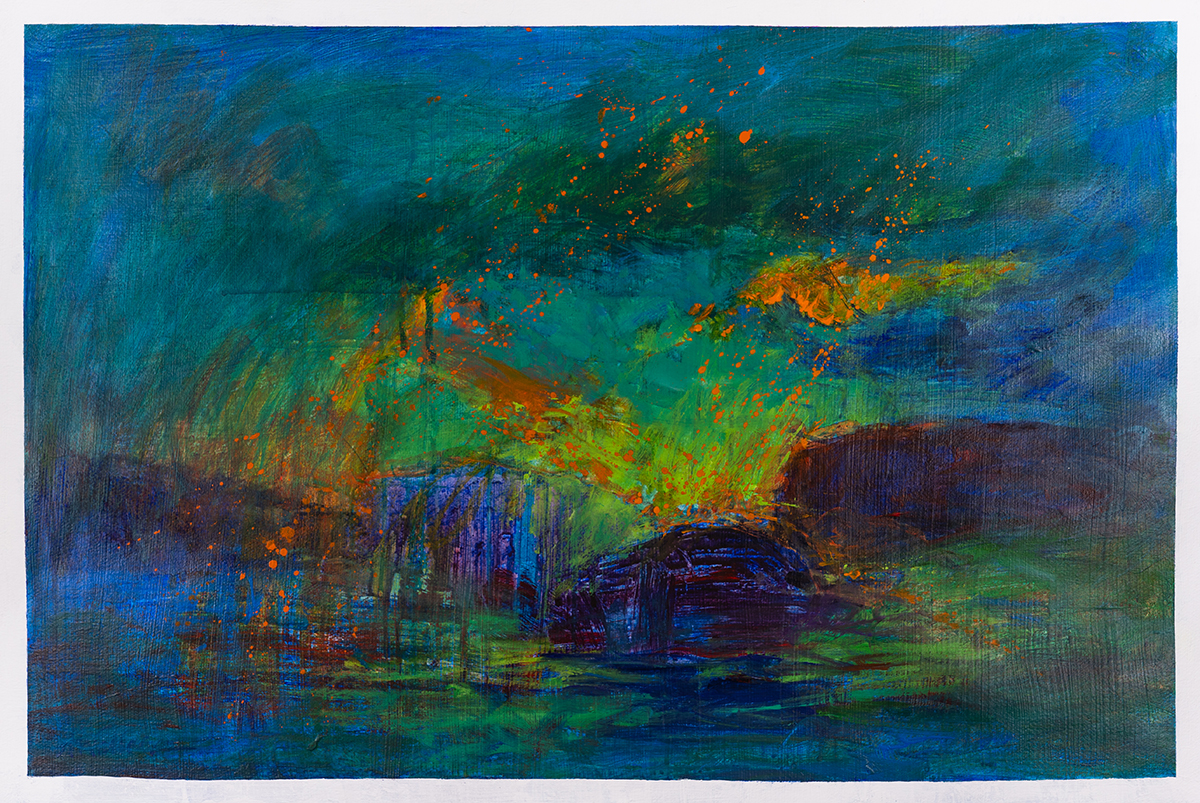
“Golden hours of vision come to us in this present life, when we are at our best, and our faculties work together in harmony.”
Charles Fletcher Dole, 1845-1927, Unitarian minister and writer
You could say that Charlottesville is at its best once a day, every day, during the golden hour. While it’s not invisible, I wonder whether it is taken for granted as our citizens transition into evening activities. This painting was created to honor the fleeting, yet impactful interlude when the sun performs its last act and presents an opportunity to come together, without controversy, in appreciation of our piece of paradise located on the 38th parallel.
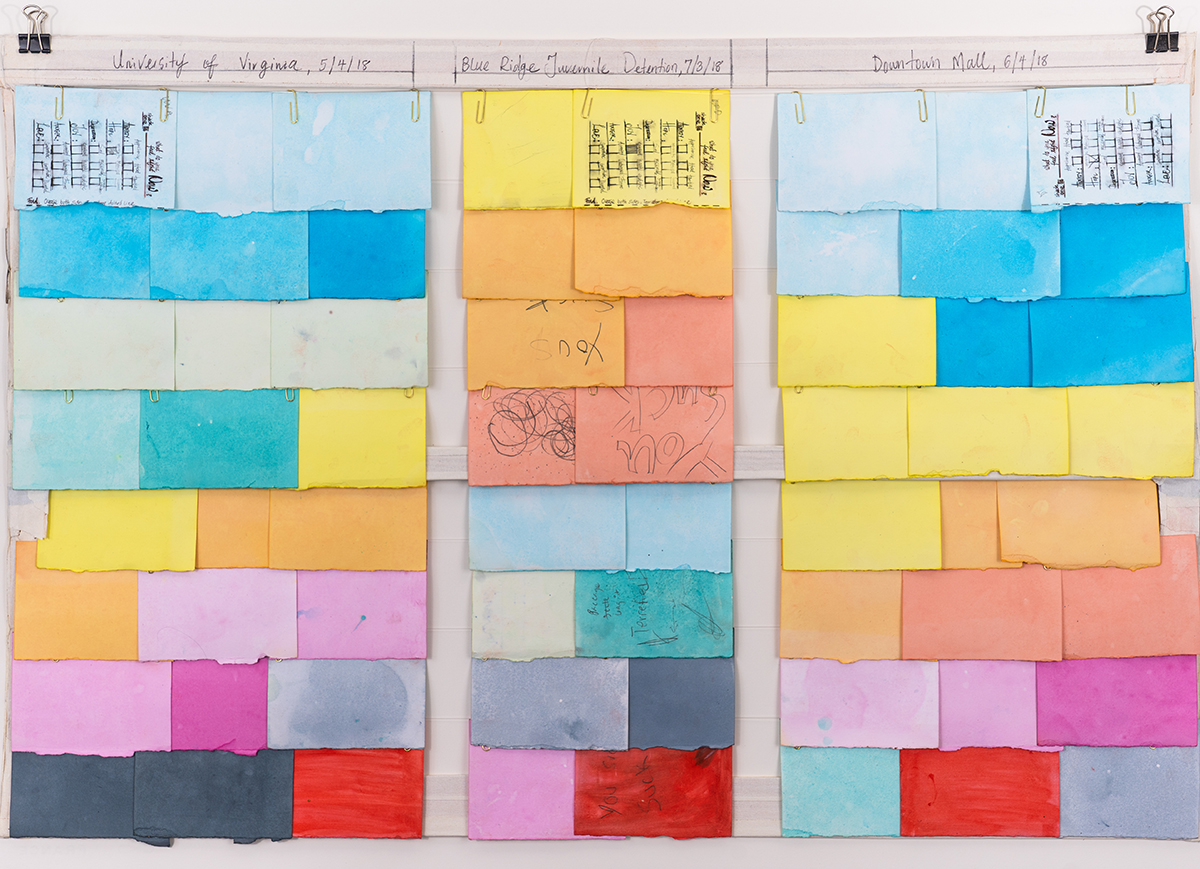
What do you feel right now? Anonymous participants answer emotion survey cards which are then dyed and assembled to form tapestry maps representing what a particular group of people felt, at a particular place and time. What do these maps show us? That the most popular emotion among surveyed UVA college students on a brisk April day is Hope, followed closely by Anxiety. That on the next day, unseasonably warm, strolling pedestrians on the Downtown Mall predominantly felt Content. That half of the teenagers at the Blue Ridge Juvenile Detention center listed Joy as their current emotion, specifically Ecstasy, and that this did not preclude the sentiment of “you suck”. What does this all mean? Perhaps not one thing. Every tapestry assembled raises its own questions and answers. The consistent thread here is there is at least one green-anxiety, blue-hope, grey-sadness, yellow-joy, red-anger and purple-love card in each map. We are all feeling differently. We are all feeling the same.
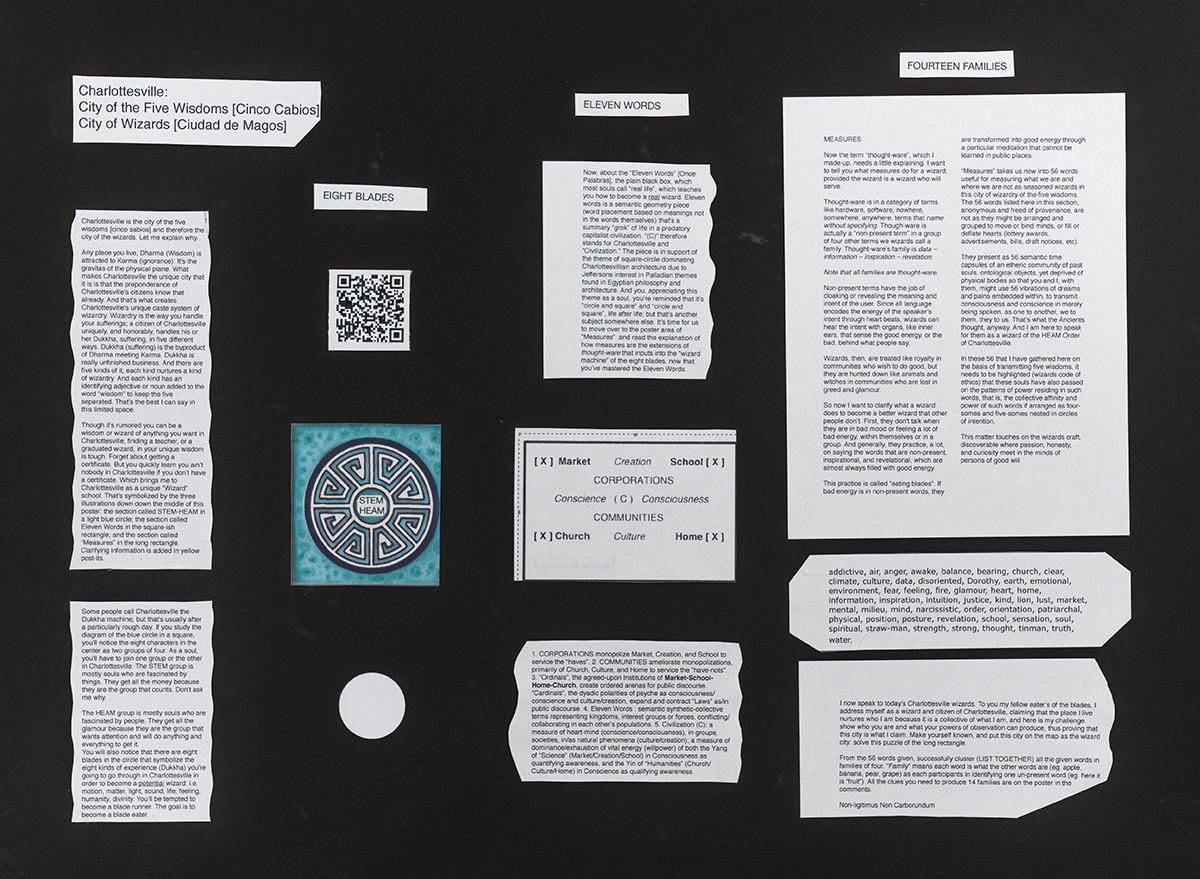
“CHV: City of the Five Wisdoms (CHV-5),” is the confluence of five personal preoccupations. In youth, the one preoccupation was a meaningful way of life. But on the way to maturity, one mystery cloned itself into four: physics/metaphysics, consilience, biophilia, and vitalism/integral ecology.
CHV-5, its text, images, and their placement reflect the rules and contents of the square-circle sacred geometry captured from the cosmos by the ancient Egyptians, organized by Palladio, and ubiquitinated by Thomas Jefferson. CHV-5 also reflects the five skandhas sacred geometry of the Orientals, captured by ancient Hindus, illuminated by Tibetan Yogis, and studied by UVA’s David Germano.
Multipurpose by design, CHV-5 presents as historical collage, life’s work summary, educational poster, and timely response to public need.
Charlottesville, “(C)” on the diagram “11 Words”, now sits on a high hill “which cannot be hid”, a beacon for many, a target for some.
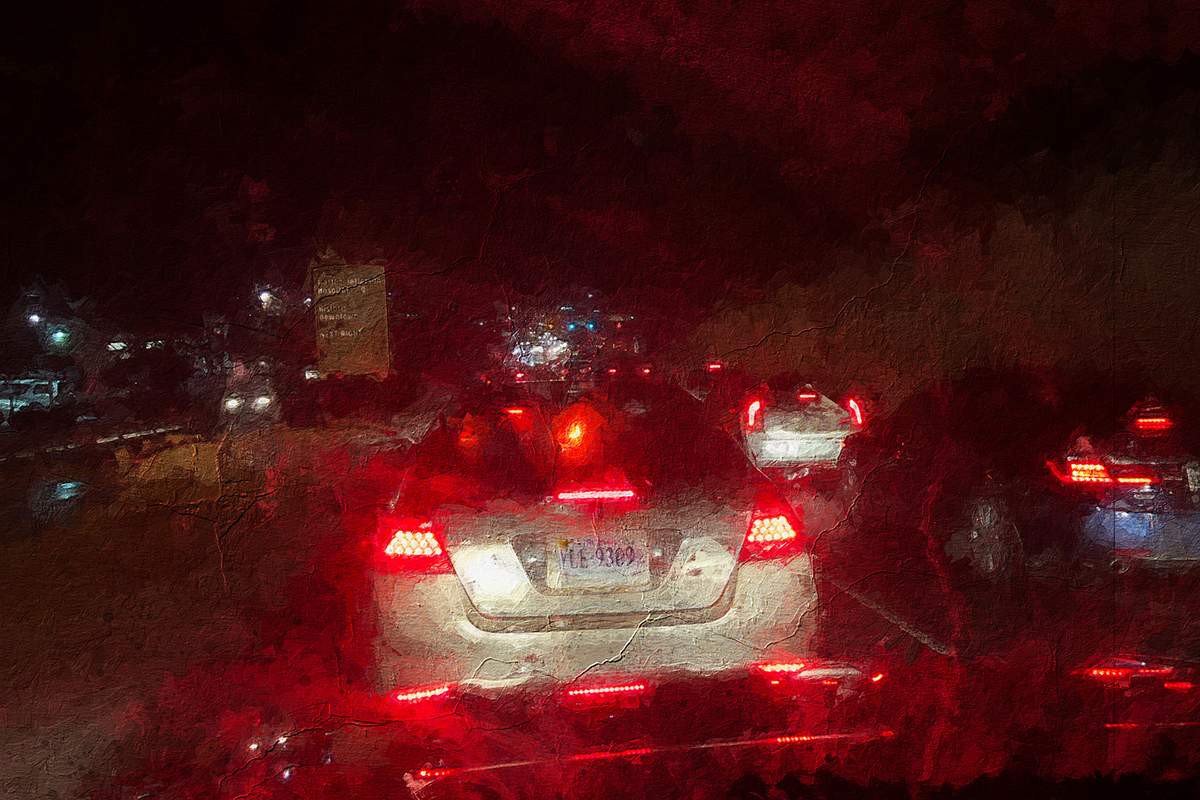
As our city grows so does the traffic. Many parts of the city are impassable, gridlocked during morning and evening rush hour. Sitting in traffic lengthens our day and makes it difficult to make appointments, run errands or enjoy going to an event. Most cars burn gas and pollute the environment with toxic exhaust. What steps can we take, individually and as a community, to reduce the number of trips per day and the overall traffic volume? What can we do to reduce the pollution generated by our commute?
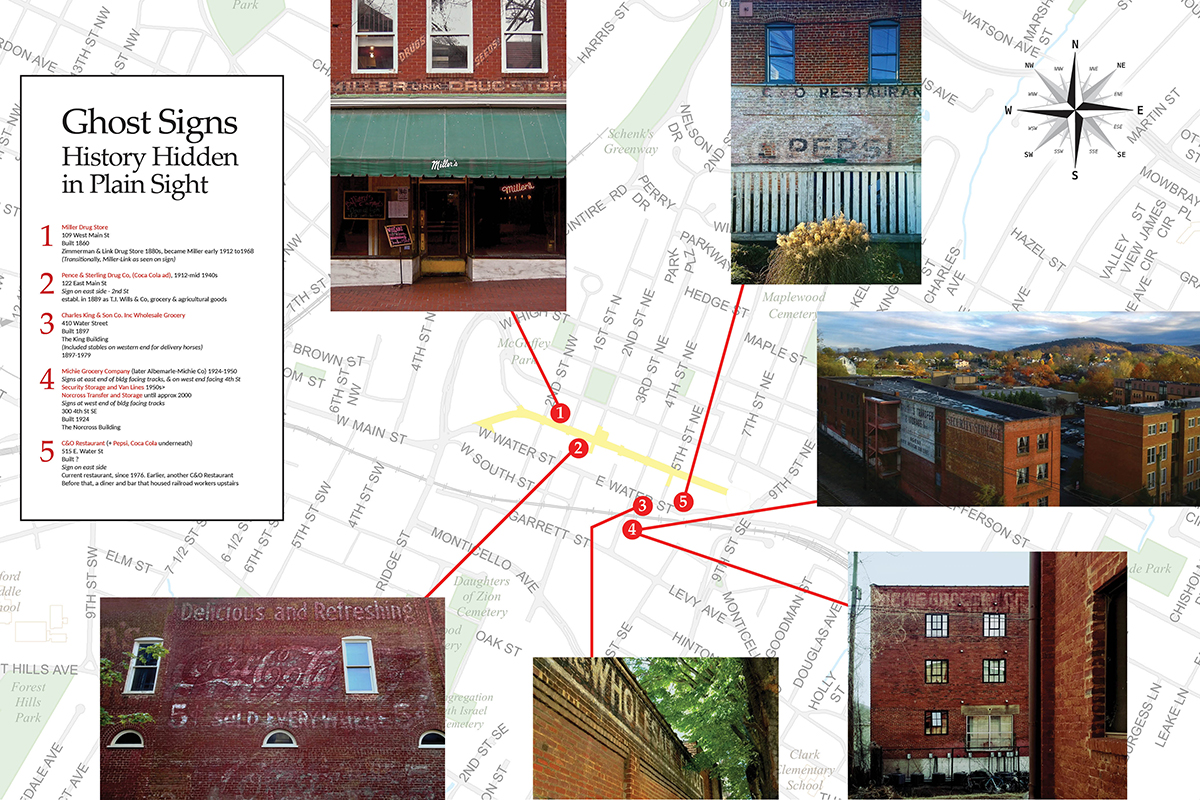
Visitors to downtown Charlottesville, and even residents, often see it only as it is today: a place to get a nice meal, catch some entertainment, visit shops. We know little of the history of buildings we visit, the stories of the earlier life of commerce in our city, the stuff of everyday life then: grocery & agricultural goods, medicine, storage, railroad workers, horses for transport, etc. Ghost signs, the fading painted signs on the sides of brick buildings, common in the late 19th-mid 20th century, can give us a glimpse back. I’m drawn to photograph the often un-noticed things, views, nuances that most people overlook, and I see ghost signs everywhere I go. They are both a lost art (their painters were called wall dogs), and a trip back into history. They can spark an interest to learn even more about what life was like here in a different time. Absorbing the past can enrich the present. Walk around town, and you can spot quite a few, even more than are pictured here.
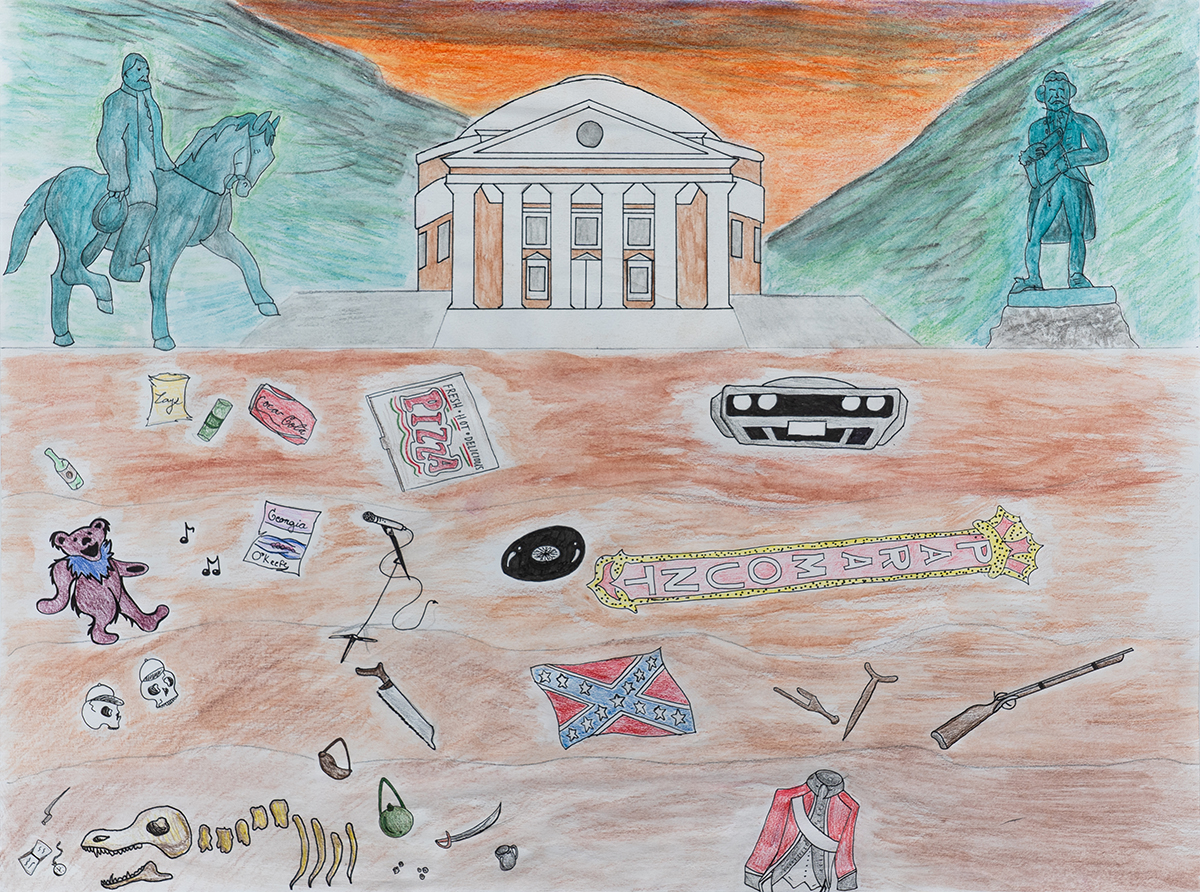
Our “Invisible C’ville” project deals with the history of Charlottesville and how it has evolved over time. We split the canvas into 5 quadrants within a landscape. The composition resembles a geological map with layers representing different time periods. The top layer represents current-day Charlottesville iconic buildings and structures found throughout the town. The first layer encapsulates pieces of the Charlottesville riots that occurred in 2017 along with trash left behind. The second layer references the pop culture of the town. The third layer includes icons of the Civil War to retell how Charlottesville helped the Confederates and even manufactured their uniforms. Finally, the fourth layer has symbolic representations of the Revolutionary War, such as a British uniform, cantine, and a sword.
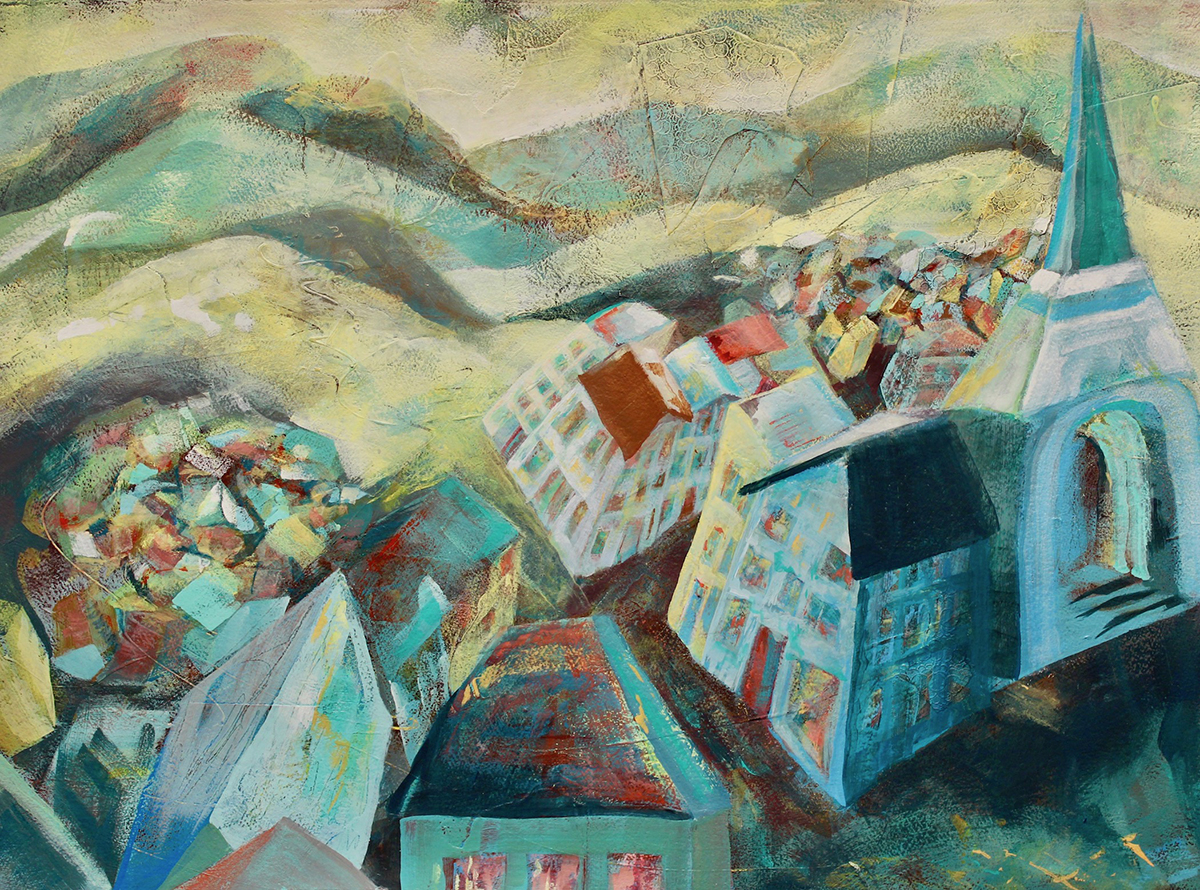
A City of Many Colors
The diversity of our citizens is a strength. At times our colors do mix and thus sometimes there is muddiness by the rubbing of the colors together. And the truth is that there is plenty of that. But still the colors can shine harmoniously.
To work to be a city that shines with its colors proudly we have to look backward to see where we have been. Putting our history behind us is not wise. Improvement can only come from looking at where we have been before.
What is in Charlottesville’s future? A colorful city with its diverse people honoring our diversity and caring about each other’s needs while remembering what has come before with pride and also in humility. The pride may keep us motivated, but humility is what blends our colors effectively as a mix of people in a way of which we can be proud. Let’s use all of our colors.
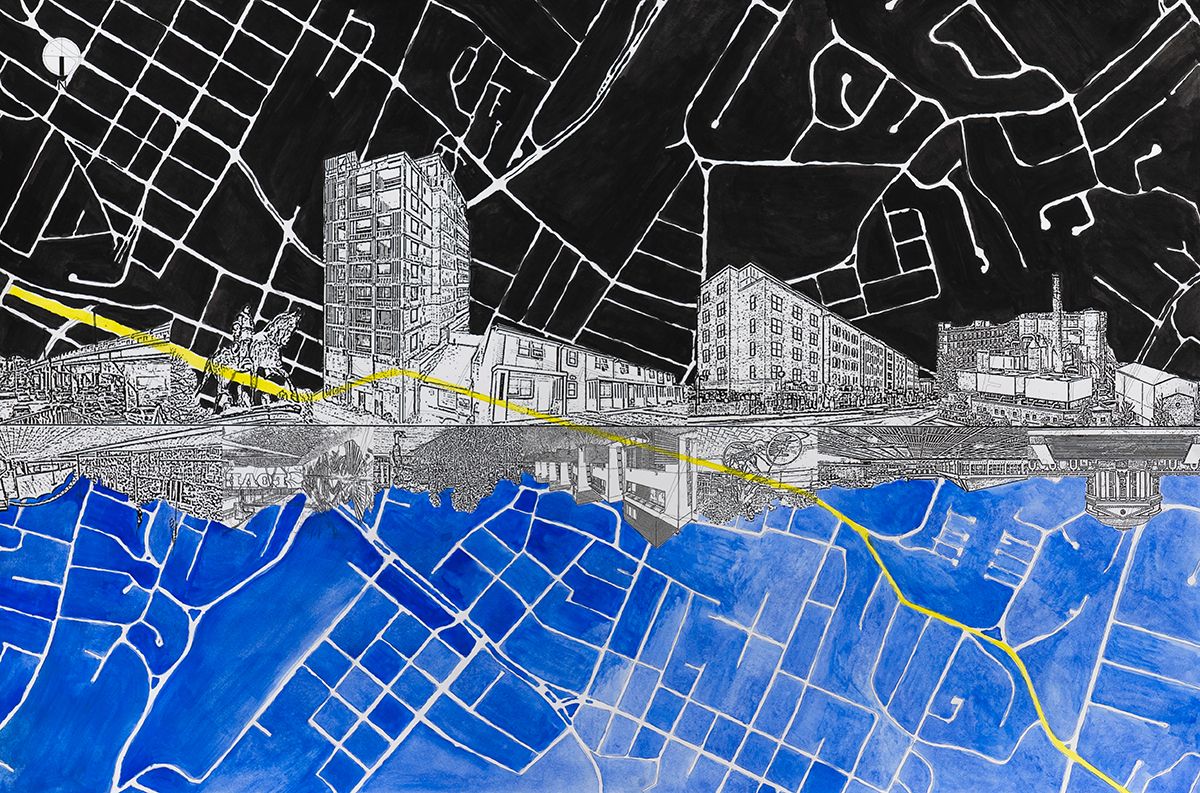
The physical constraints of an existing urban environment are only exacerbated by those imposed upon it by the maze of complex social issues. Charlottesville’s history provides significant obstacles to be followed, preserved, updated and corrected. Its assertion to certain accolades creates an unrealistic veiled identity that promotes a progressive character while resisting real change. Its lack of space for meaningful urban development coupled with the recent vague developments demand thoughtful retrospect and improved planning. Its challenge is to holistically integrate this built environment, infrastructure, growth, equality, affordability and sustainability while preserving the fundamental identity. Successful projects and (re)development can build on one another establishing a vocabulary for the future. The Main Street Corridor connecting the University and the Downtown Mall can reflect those possibilities and be a thoughtful example for positive change to the rest of the City.
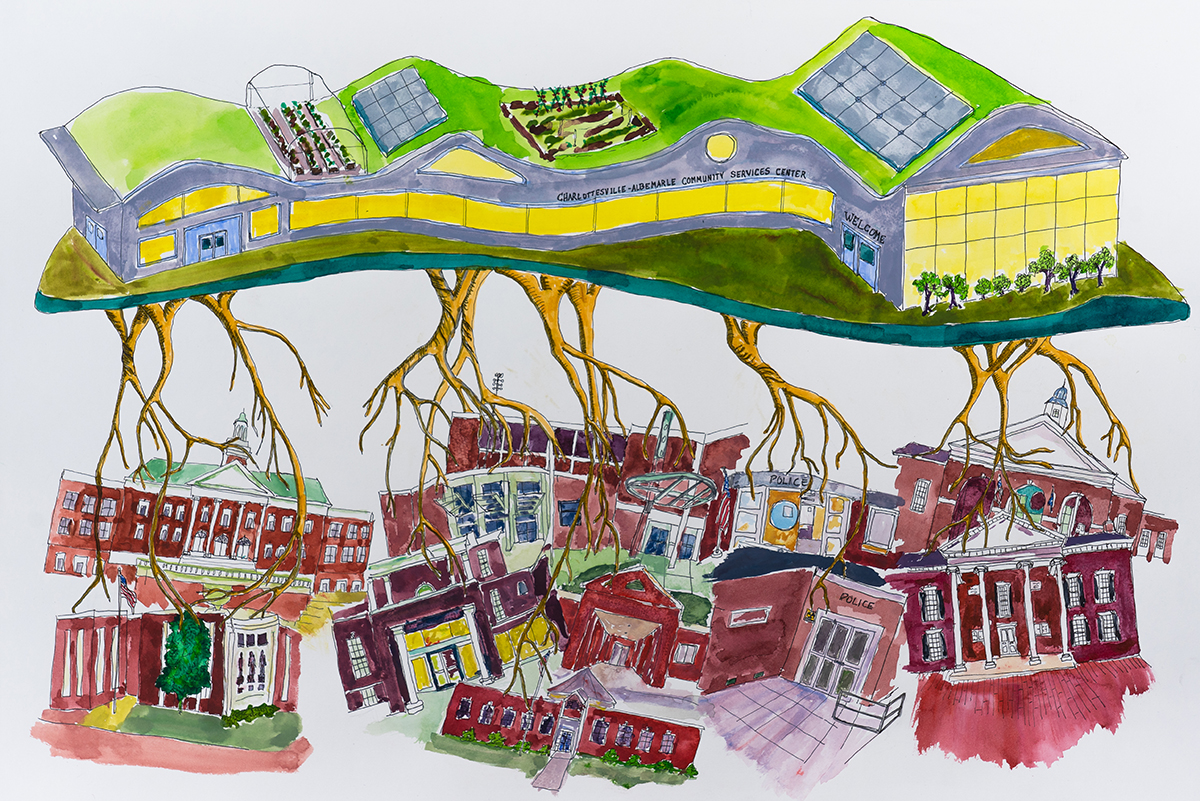
Two superintendents. Two departments of social services, two police departments, two departments of parks and recreation, two school divisions. One community.
One community.
We can do better. We can have more options for students who want a study is one of our specialty high schools. We can help smooth the way for the students who move from city to county or county to city and have to start over with a new social worker, new school, and new curriculum.
Given time, given five years, we can merge departments, merge systems, increase efficiency, reduce overhead, and increase the wonders available to the people of Charlottesville and Albemarle. We can gather all the best of what we’ve got.
Let’s look at what’s possible, not what can get in the way, but what is possible to give us all - ALL - the very best shot.
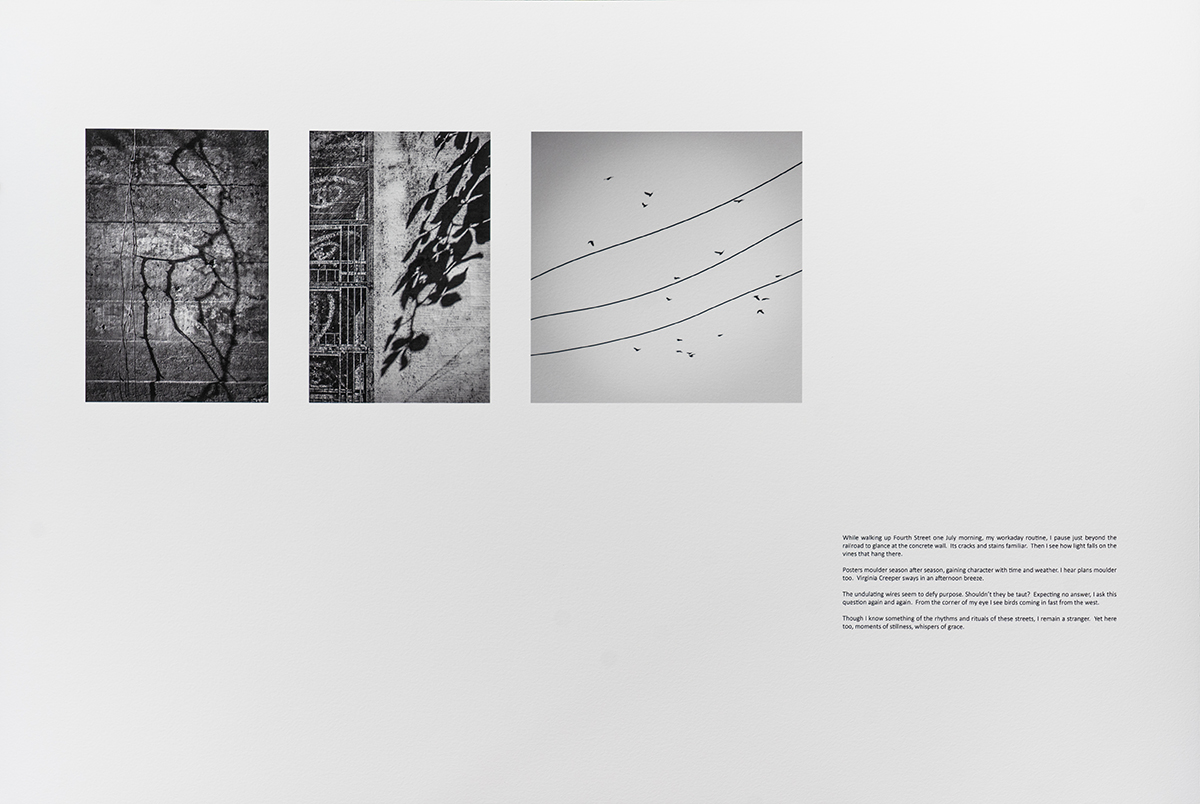
While walking up Fourth Street one July morning, my workaday routine, I pause just beyond the railroad to glance at the concrete wall. Its cracks and stains familiar. Then I see how light falls on the vines that hang there.
Posters moulder season after season, gaining character with time and weather. I hear plans moulder too. Virginia Creeper sways in an afternoon breeze.
The undulating wires seem to defy purpose. Shouldn’t they be taut? Expecting no answer, I ask this question again and again. From the corner of my eye I see birds coming in fast from the west.
Though I know something of the rhythms and rituals of these streets, I remain a stranger. Yet here too, moments of stillness, whispers of grace.
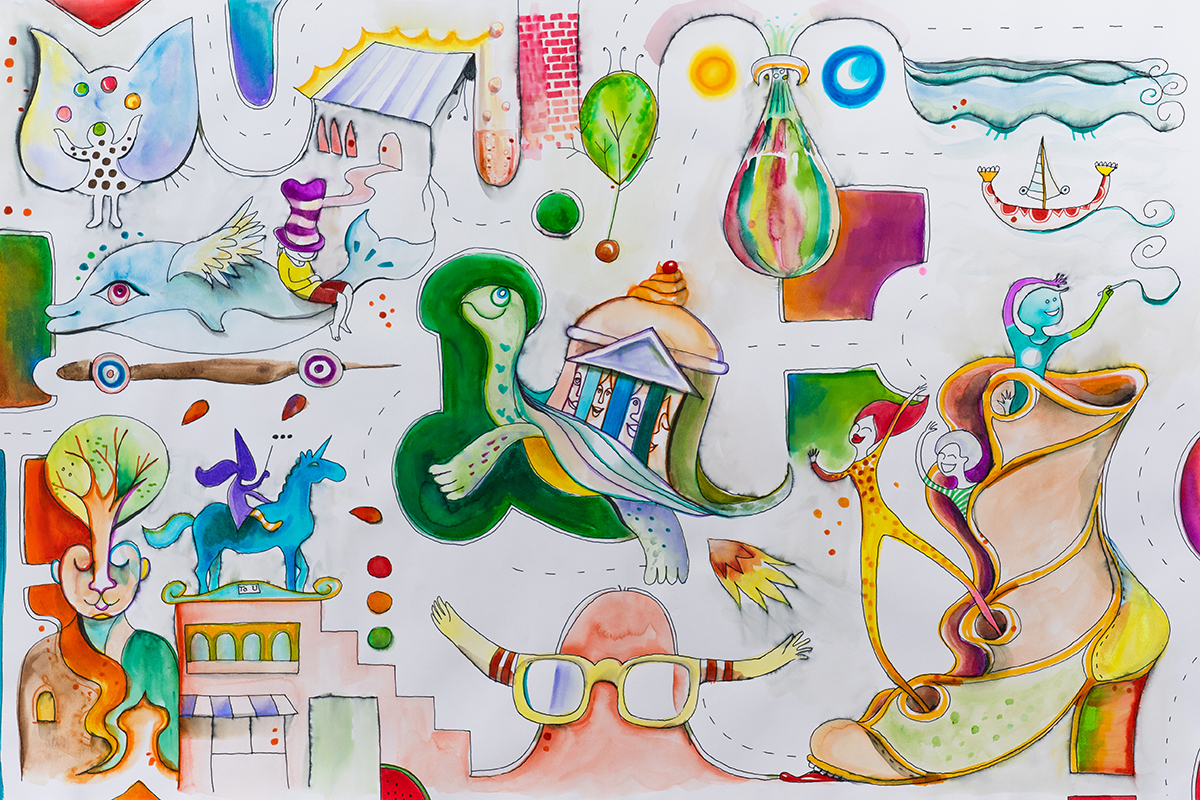
Adults risk living woefully dull lives. Were it not for the imagination of children, adults may remain trapped within a one-dimensional reality, where black and white, facts and figures, and ticks and tocks rule the day. But, in a child’s world, where blueberries dance, time backbends and cartwheels, and magic wands bestow wings, we can fly to higher realms and discover new territories. We just have to allow ourselves time to stroll beyond the Excel grids and checklists that box us in. So, who better than children to take us beyond the obvious and beneath the veneer of etiquette and convention, towards a kaleidoscopic reality and an ethos based on possibility and emergence. We may discover a tablet that makes water potable, or panels that capture the sun’s rays. Or we may simply discover pure, unadulterated joy within ourselves. Curiosity and a beginner’s mindset are the portal through which we can encounter magic, invention and invisible cities.
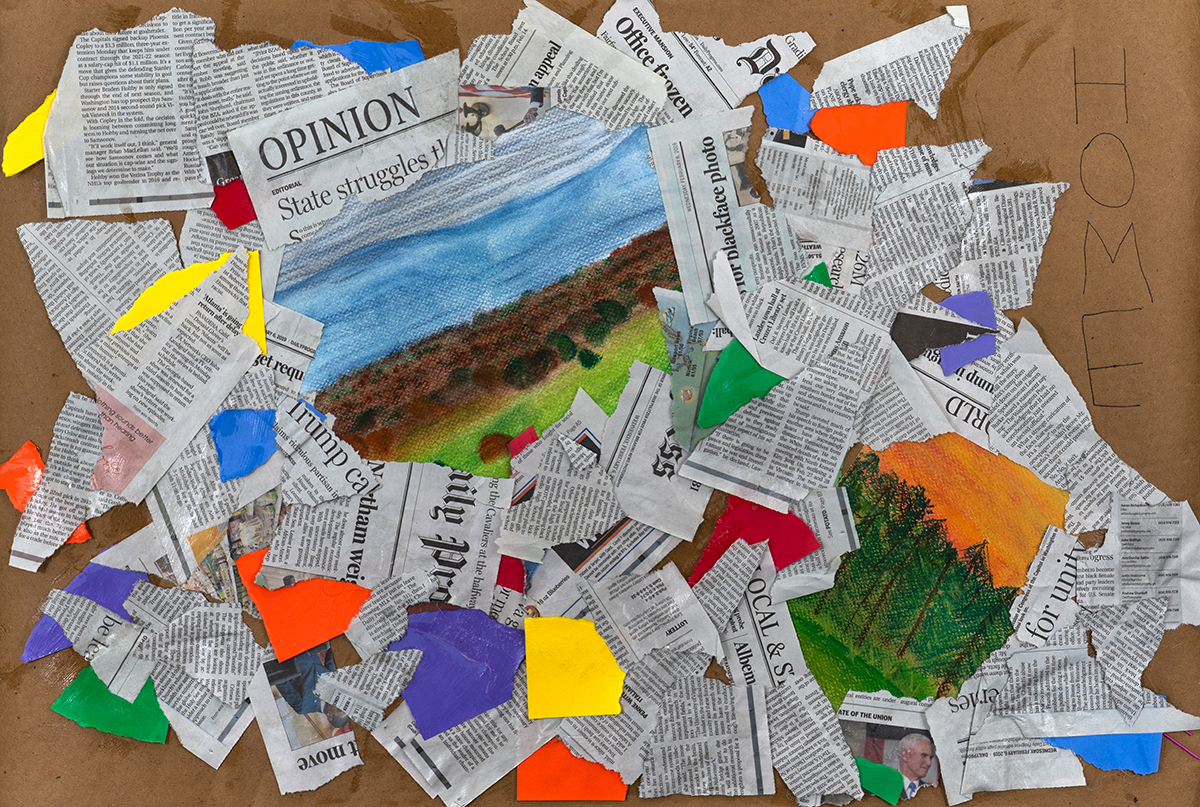
Even natural beauty can be shrouded by the dark flavor of society. In this piece, this message is encapsulated using a conglomerate of mediums. Chalk pastel drawings depict the artist’s personal favorite views of Charlottesville: the Blue Ridge in fall, and a backyard highlighted by one particularly beautiful sunset. Artfully placed local newspaper clippings cover the edges of these drawings, creating a contrast between physical beauty and the currently mixed political tide. Finally, shards of colorful paper are mixed in with the background to demonstrate the attempts of Charlottesville’s community to combat the hate that threatens it, and to make the point that many beams of light exist within the dark. In total, this piece is the artist’s view of Charlottesville: a beautiful image shrouded in a rugged frame.
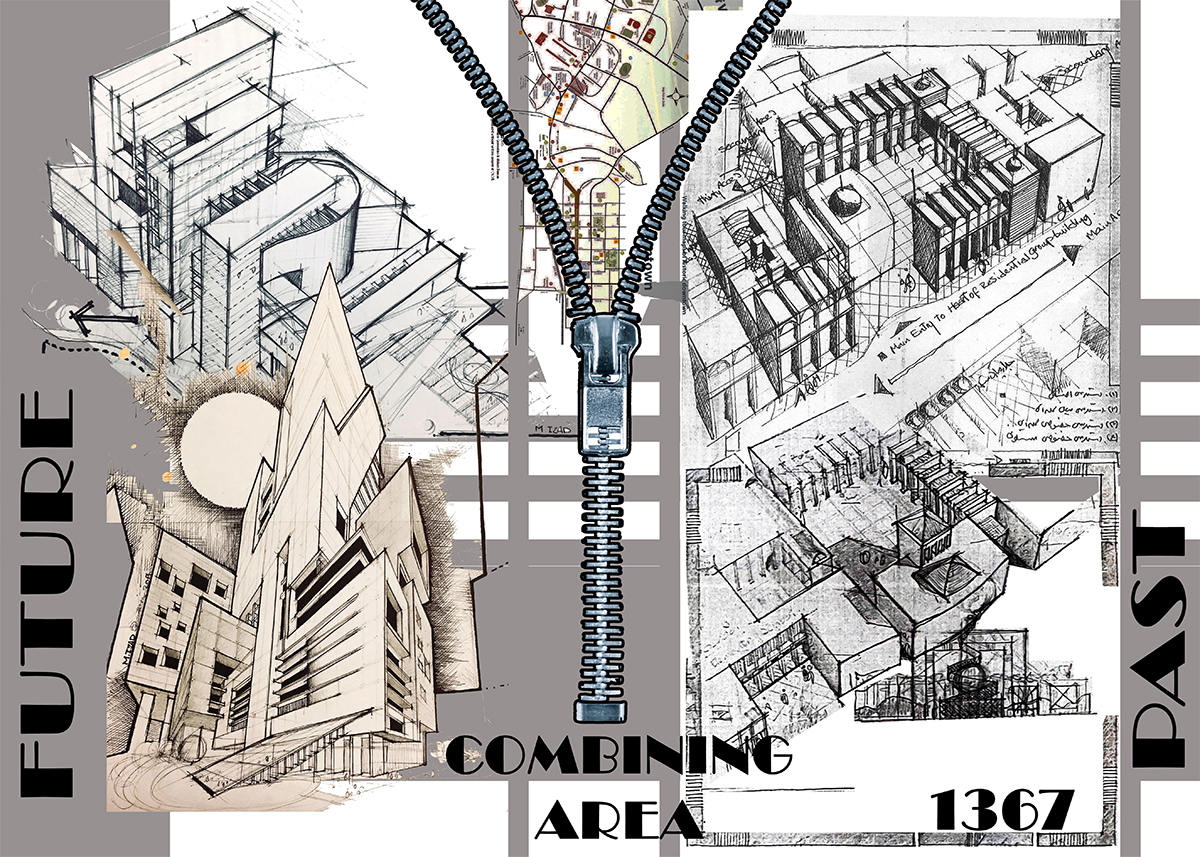
Combining modernism and traditionalism in order to create new space challenging for living and loving people each other and their town. “space- in-between”. post-revolutionary architecture and urbanism in charlottesville. “continued to take place within two integrated spaces of modernism and Traditional”. We need new process of revolution in urban exchanging. it is neither a traditional city nor a modern, it is all about something between two area of traditional and modern spaces within integrated and unique style in contemporary urban life styles and saving the past to giving it to future. Giving our ceremonies and memorial focal points to our children.
integrated spaces ' Space-in-Between'